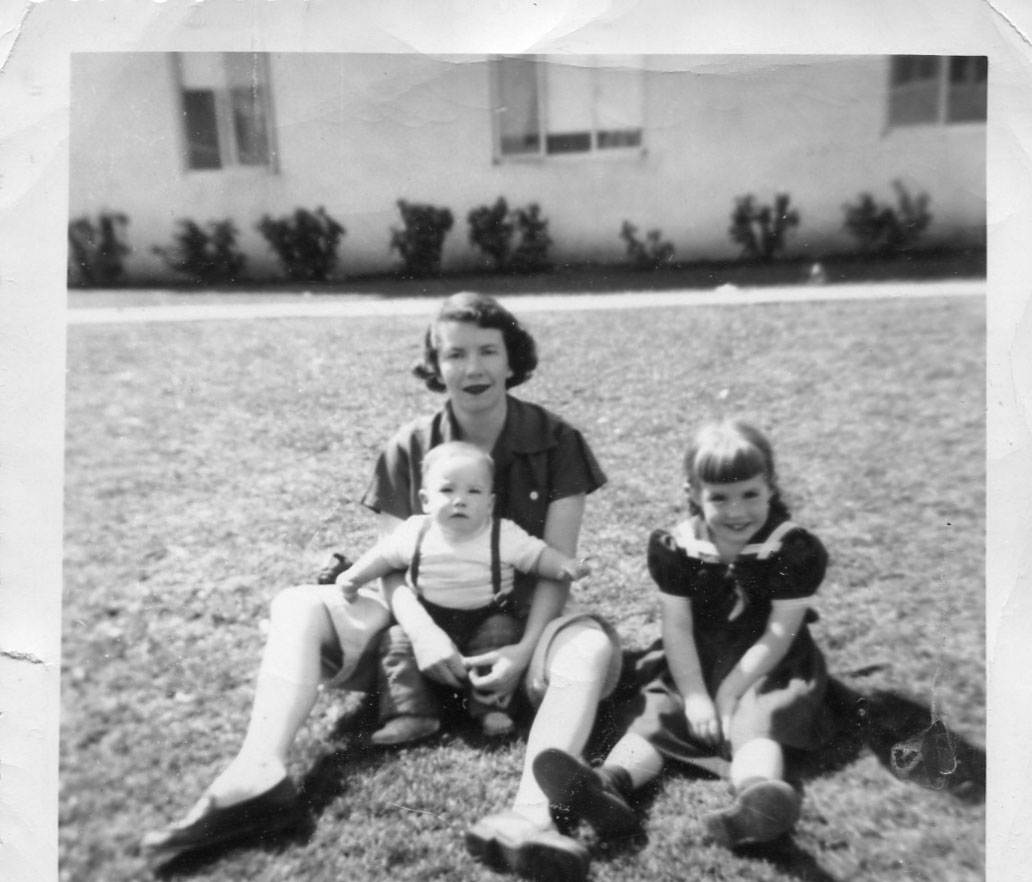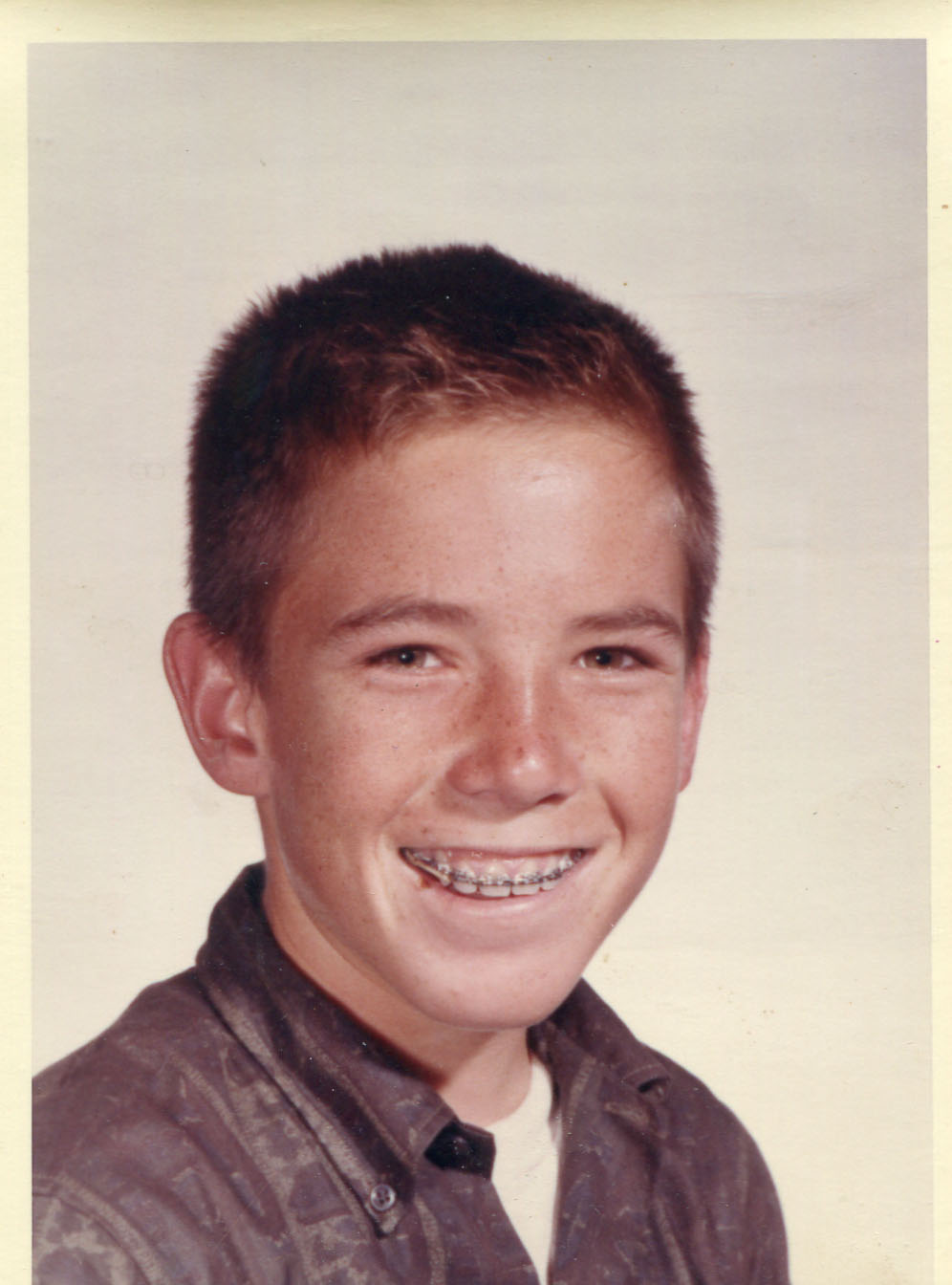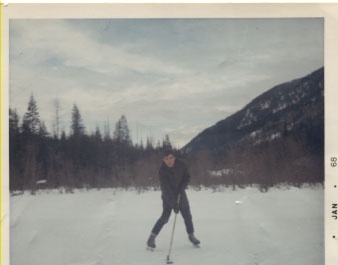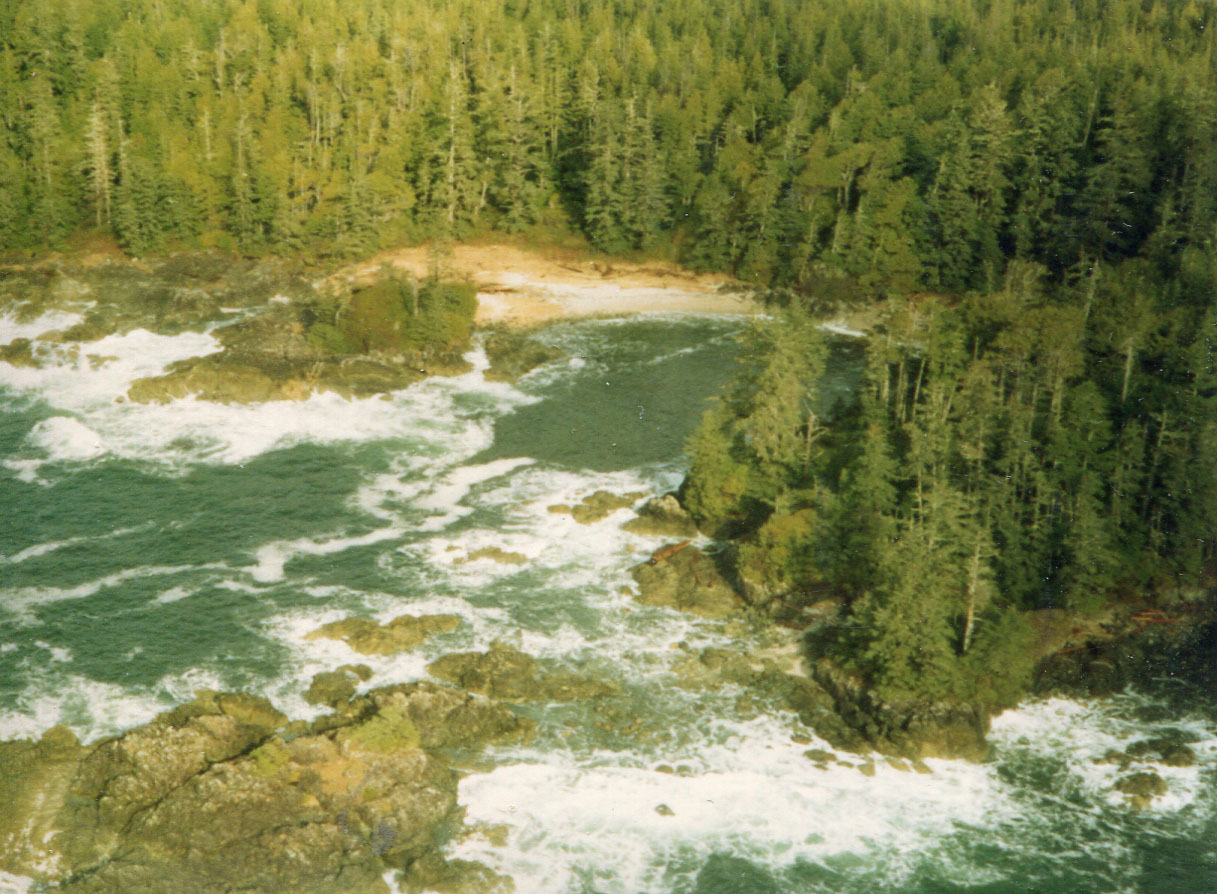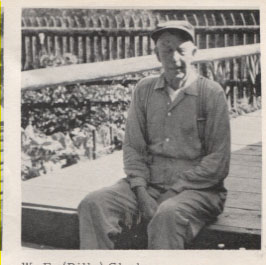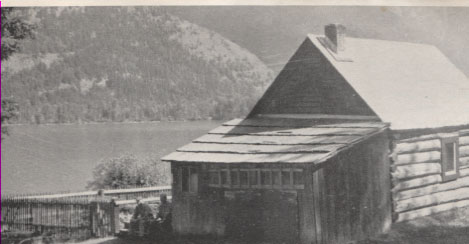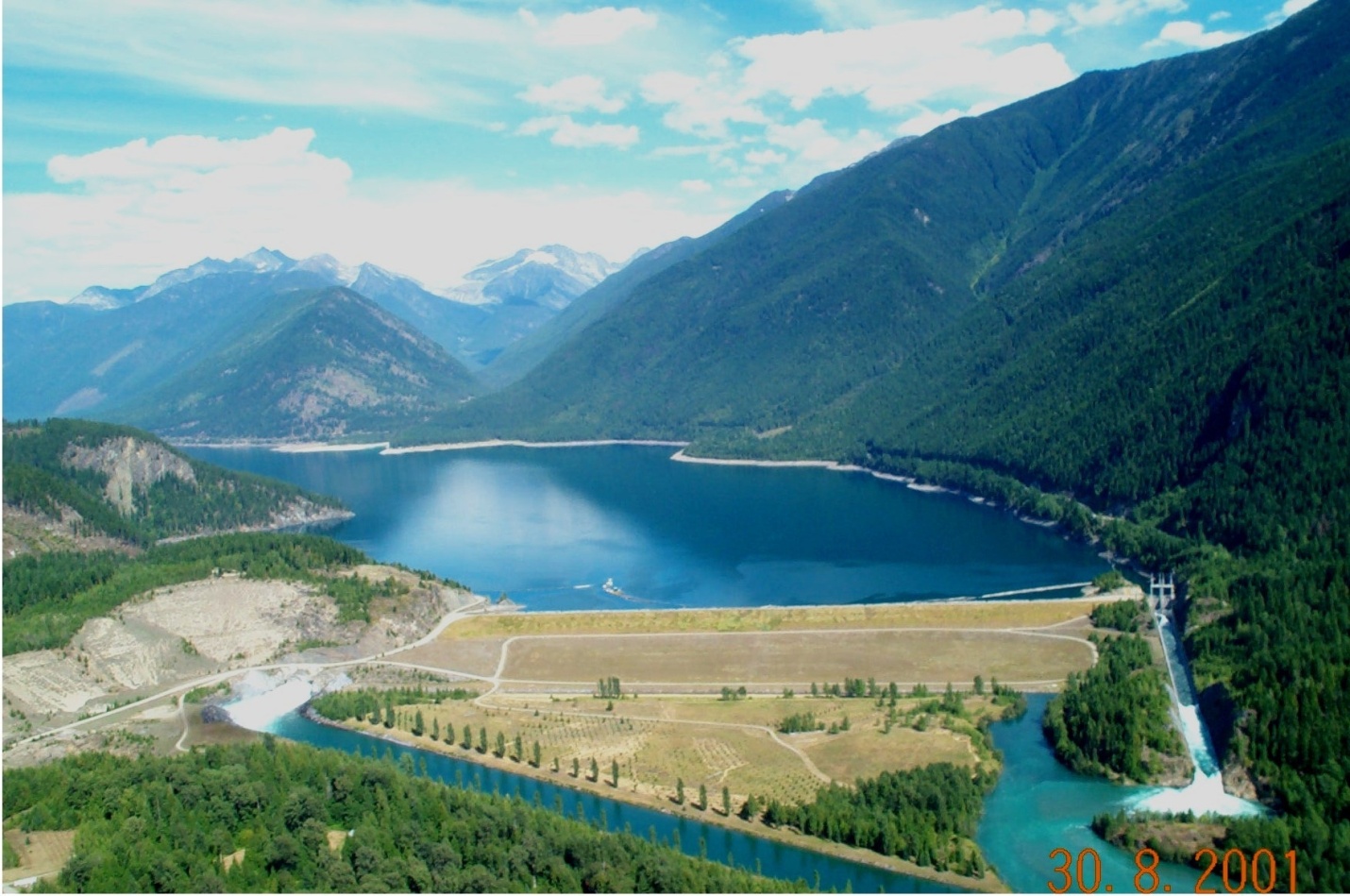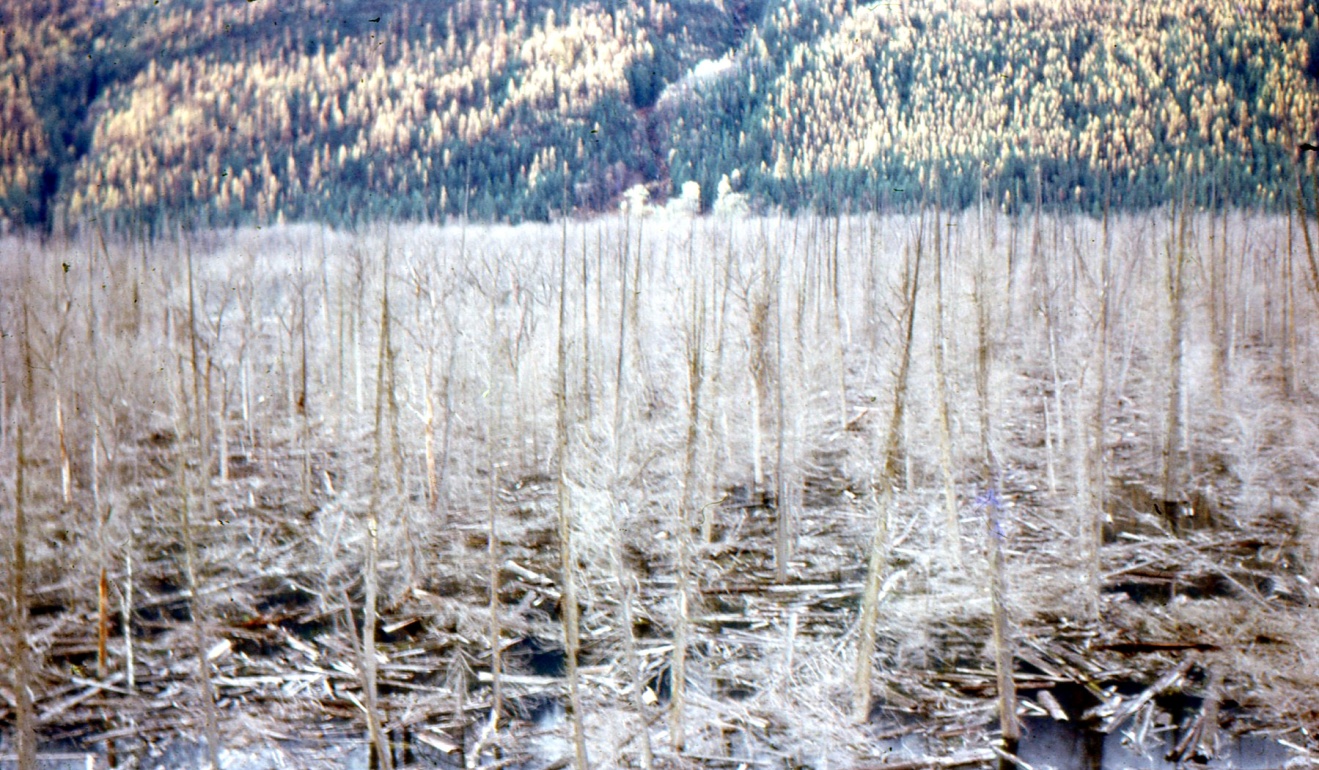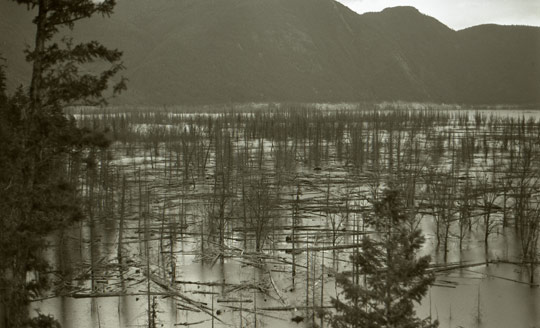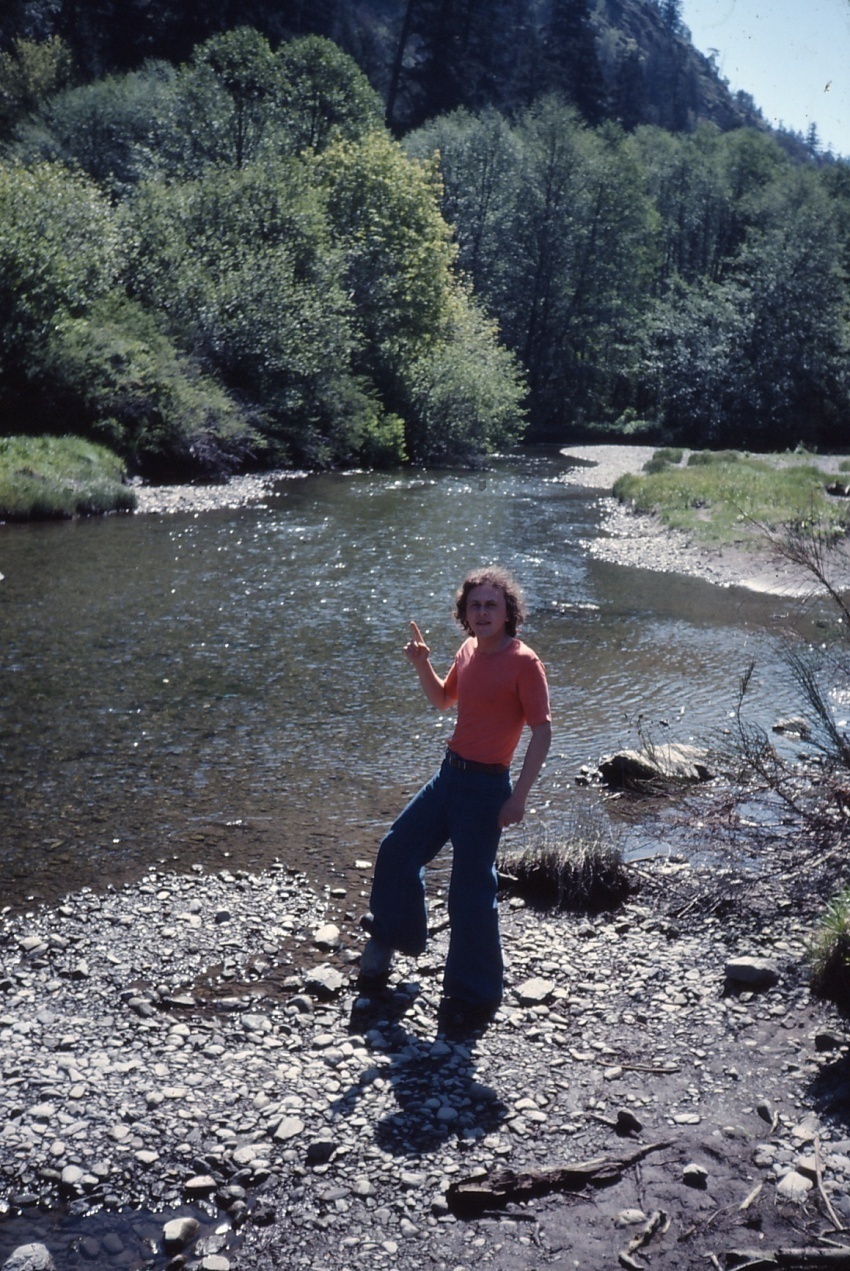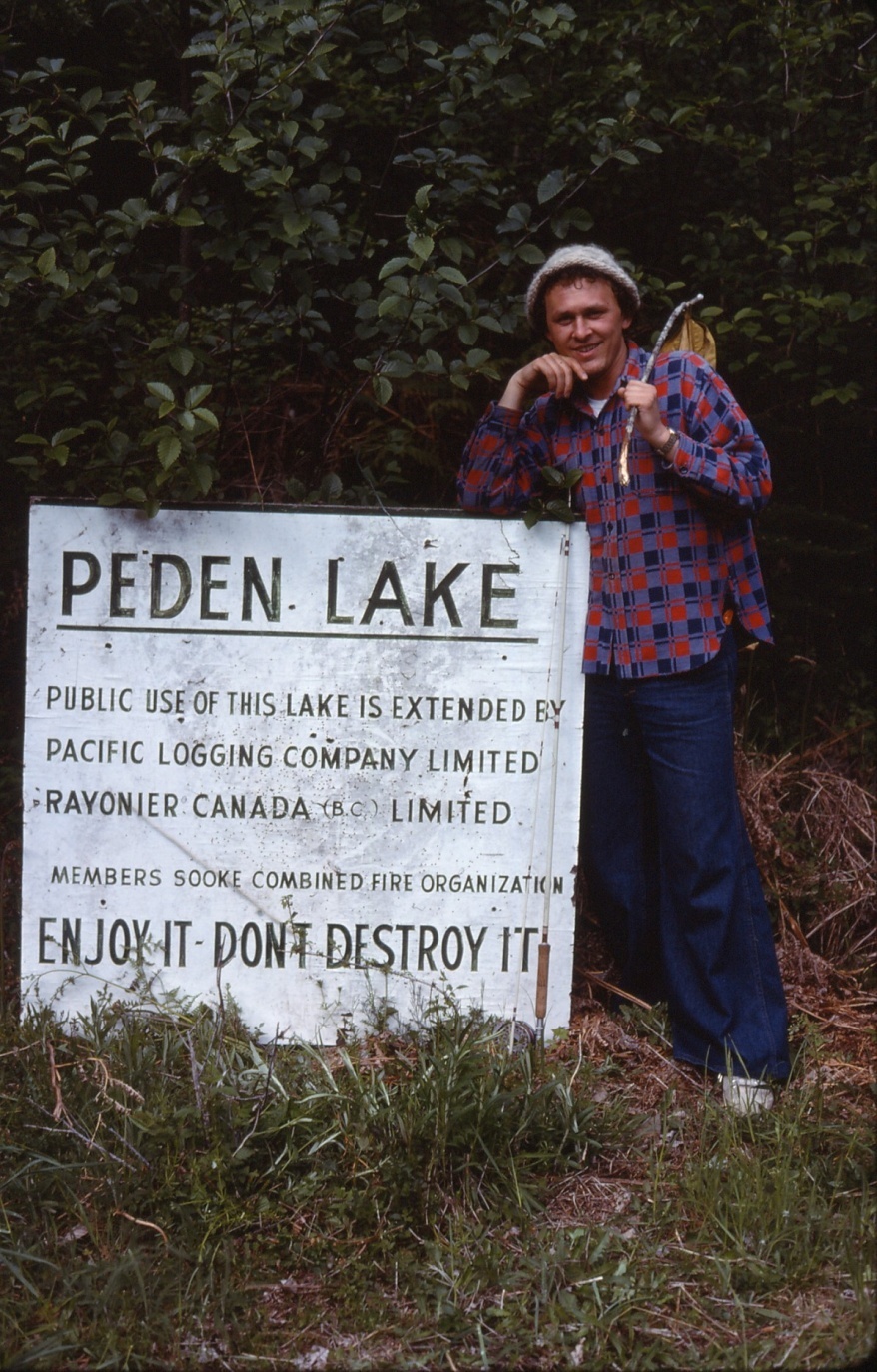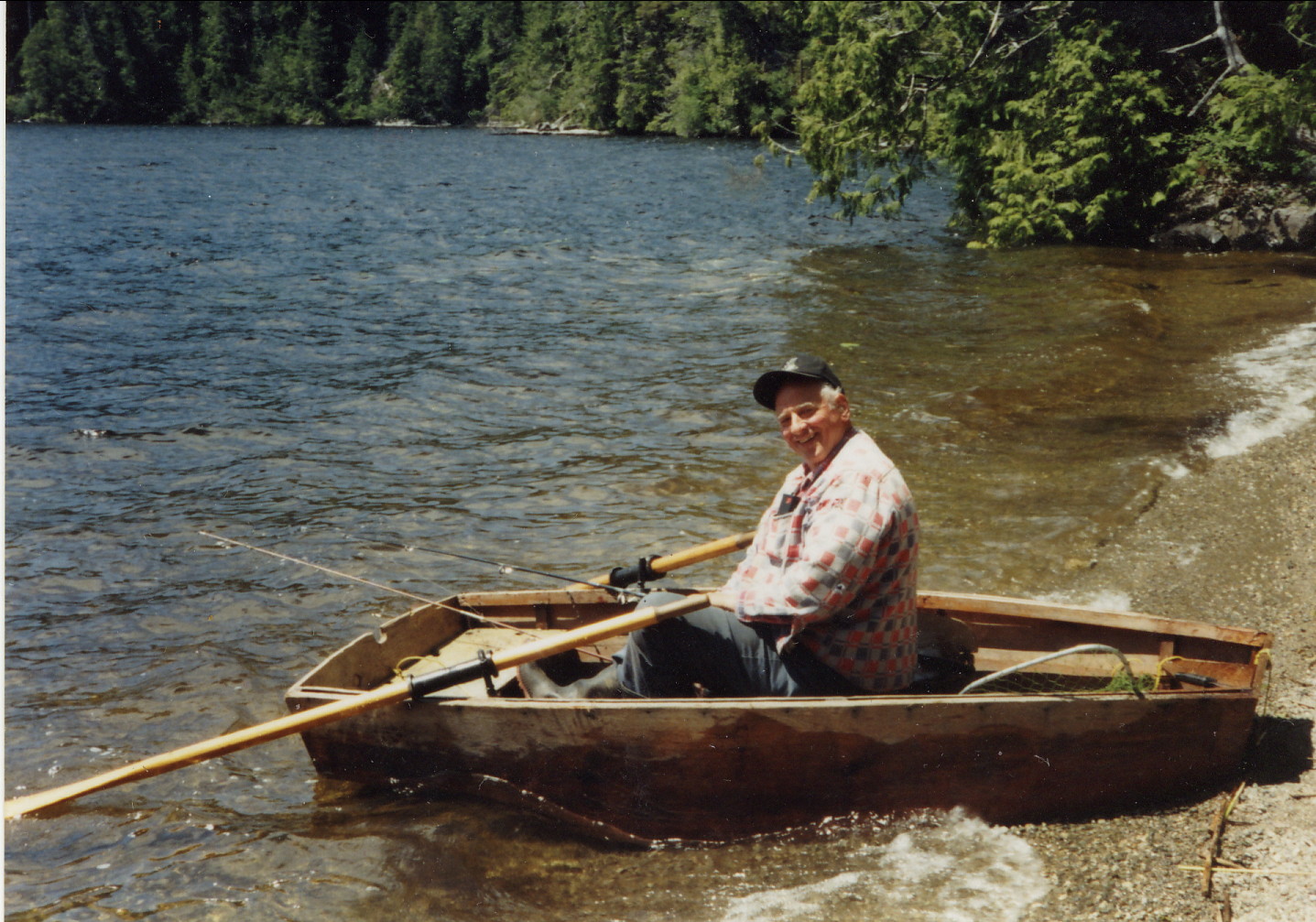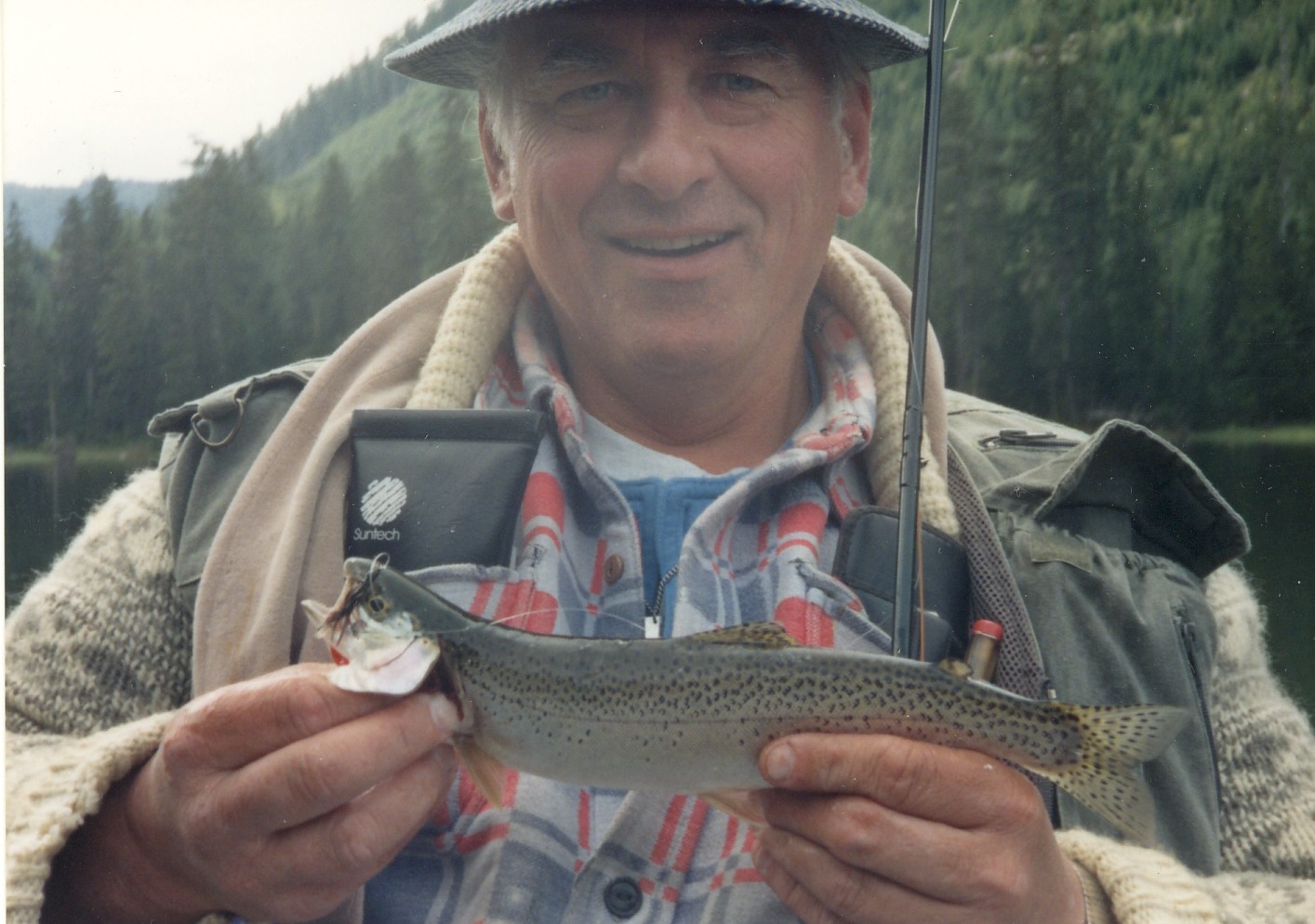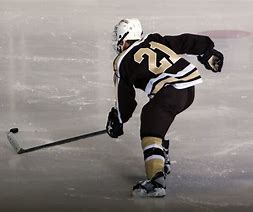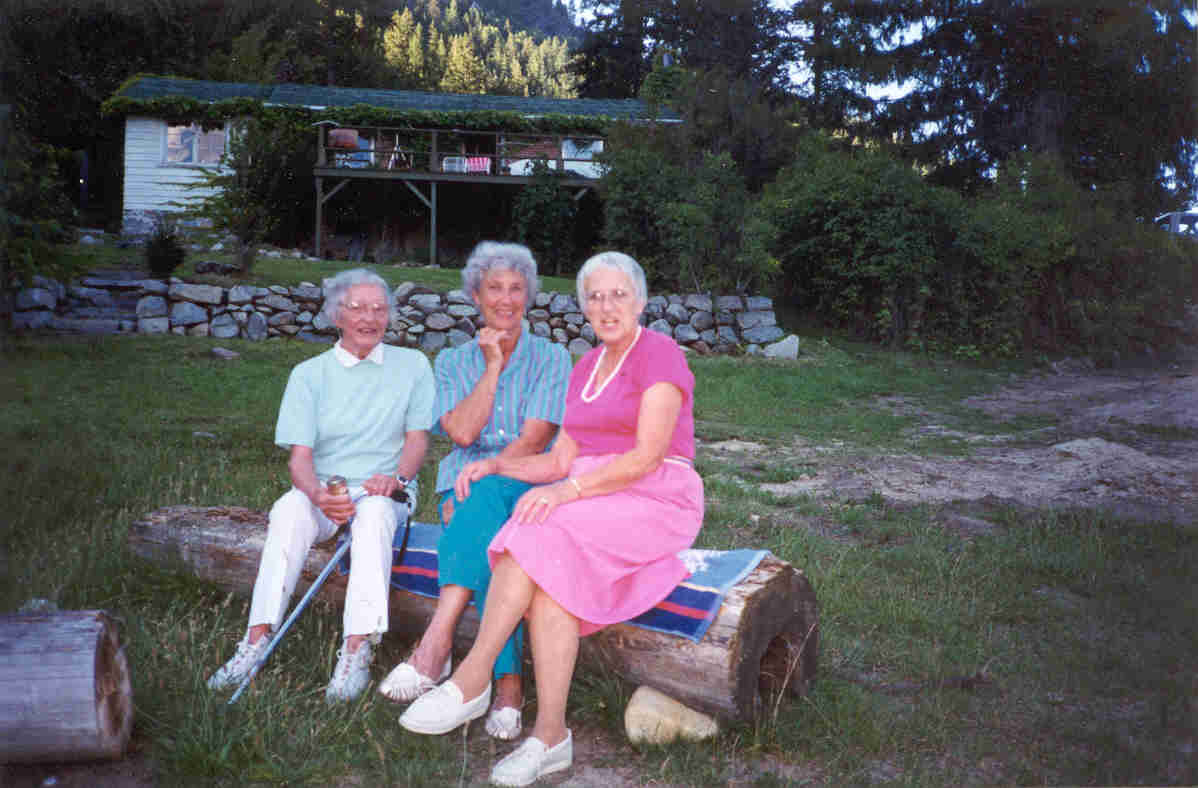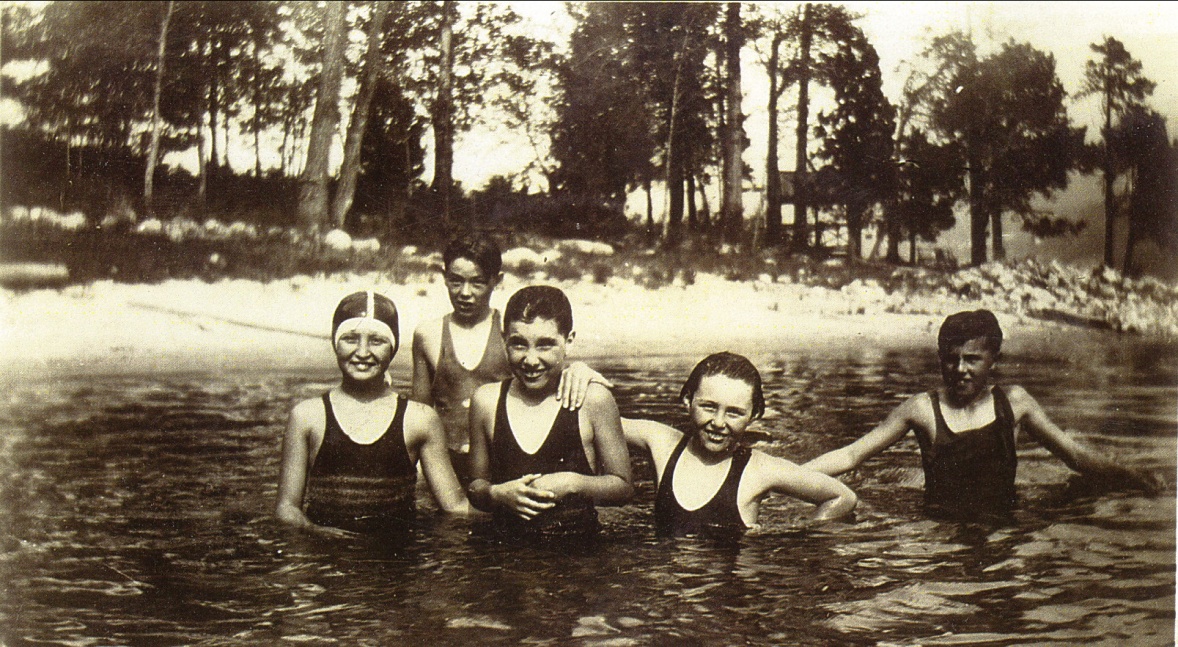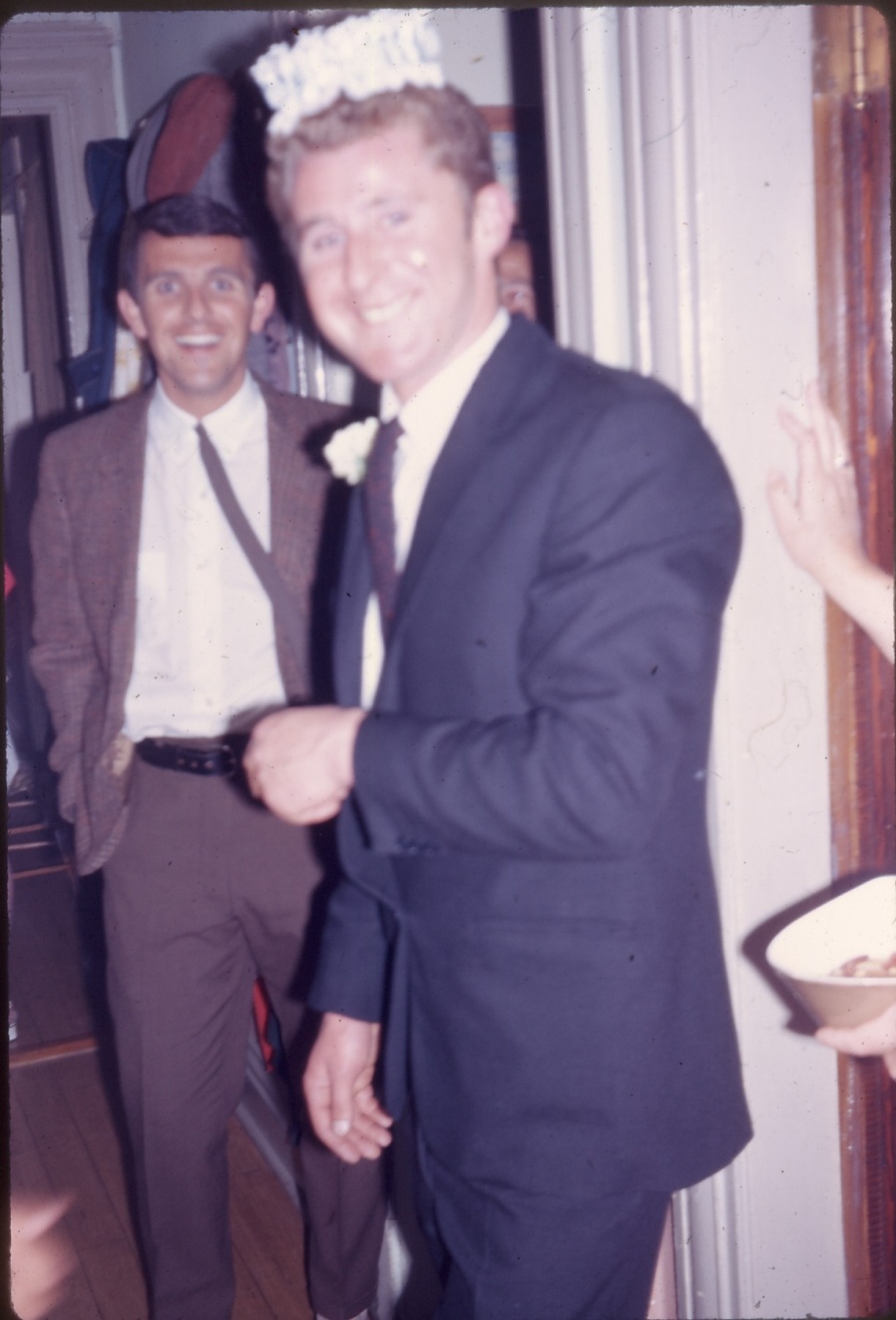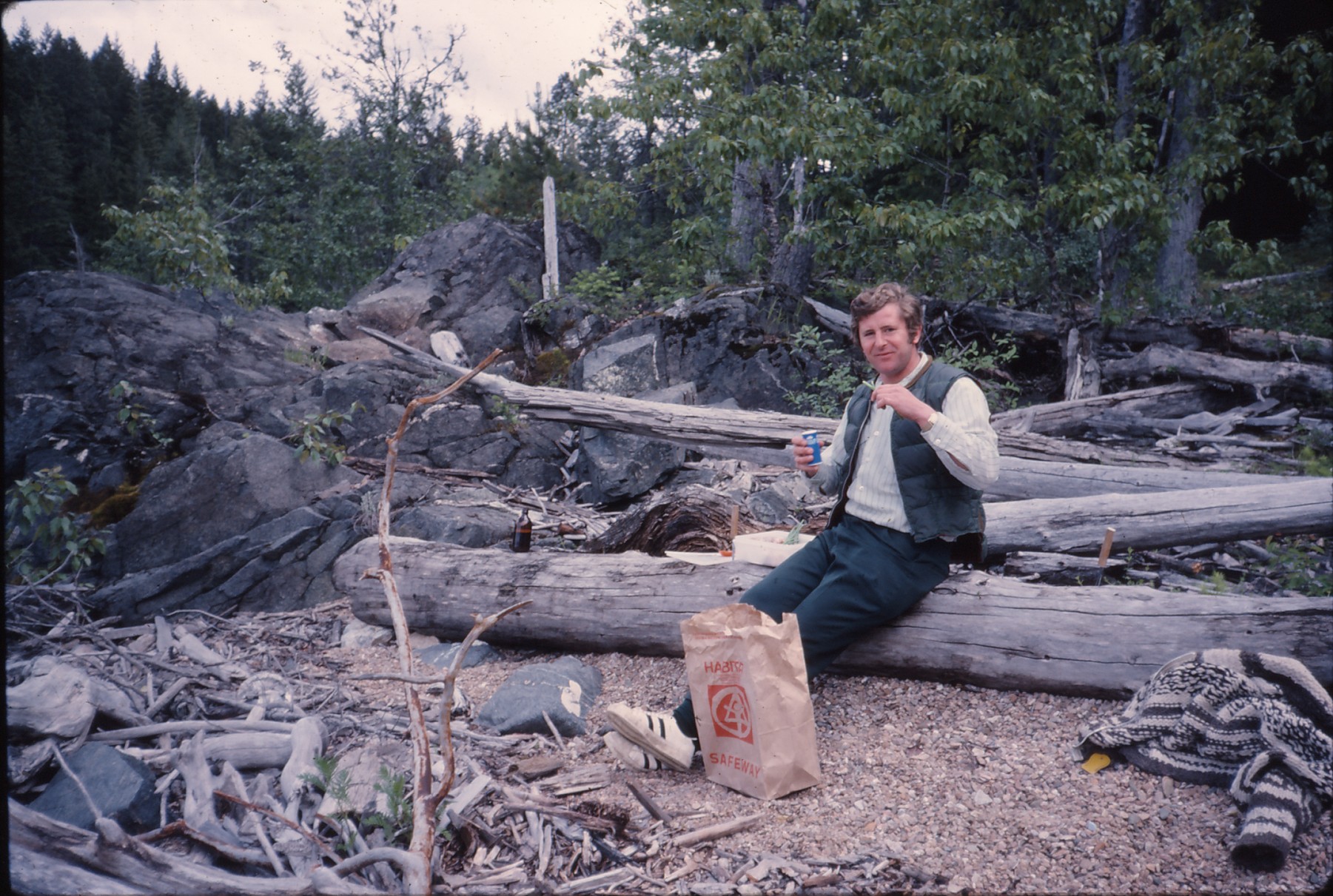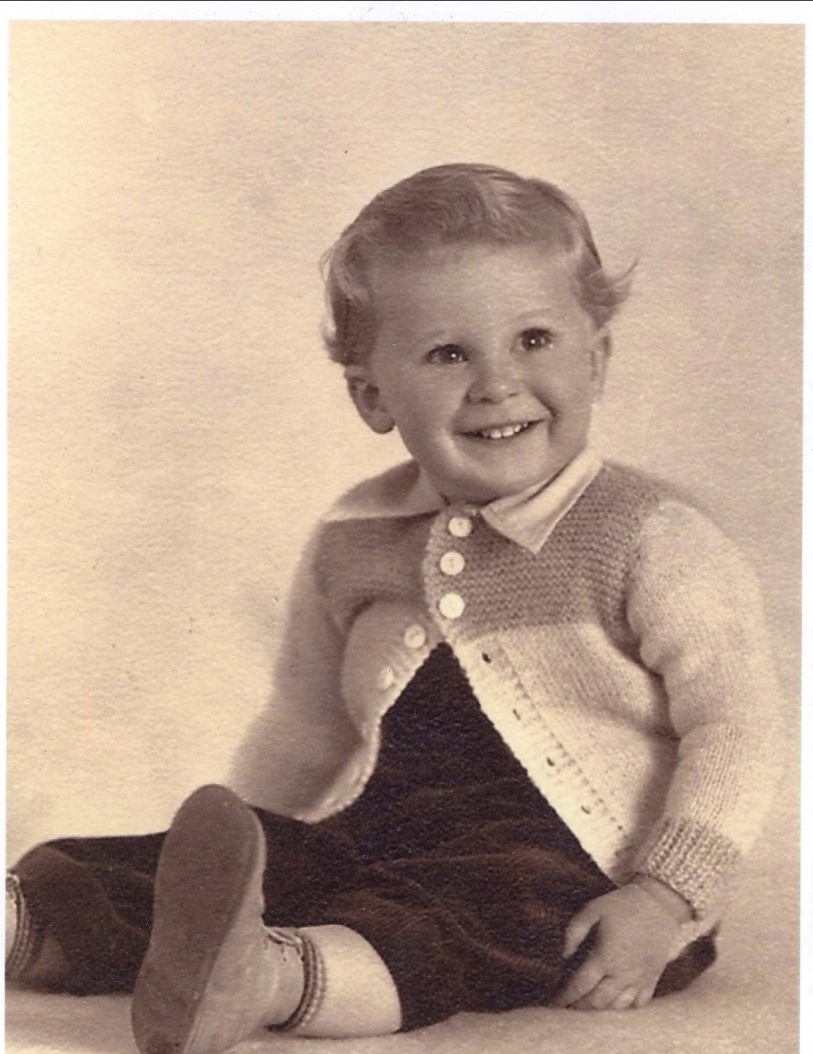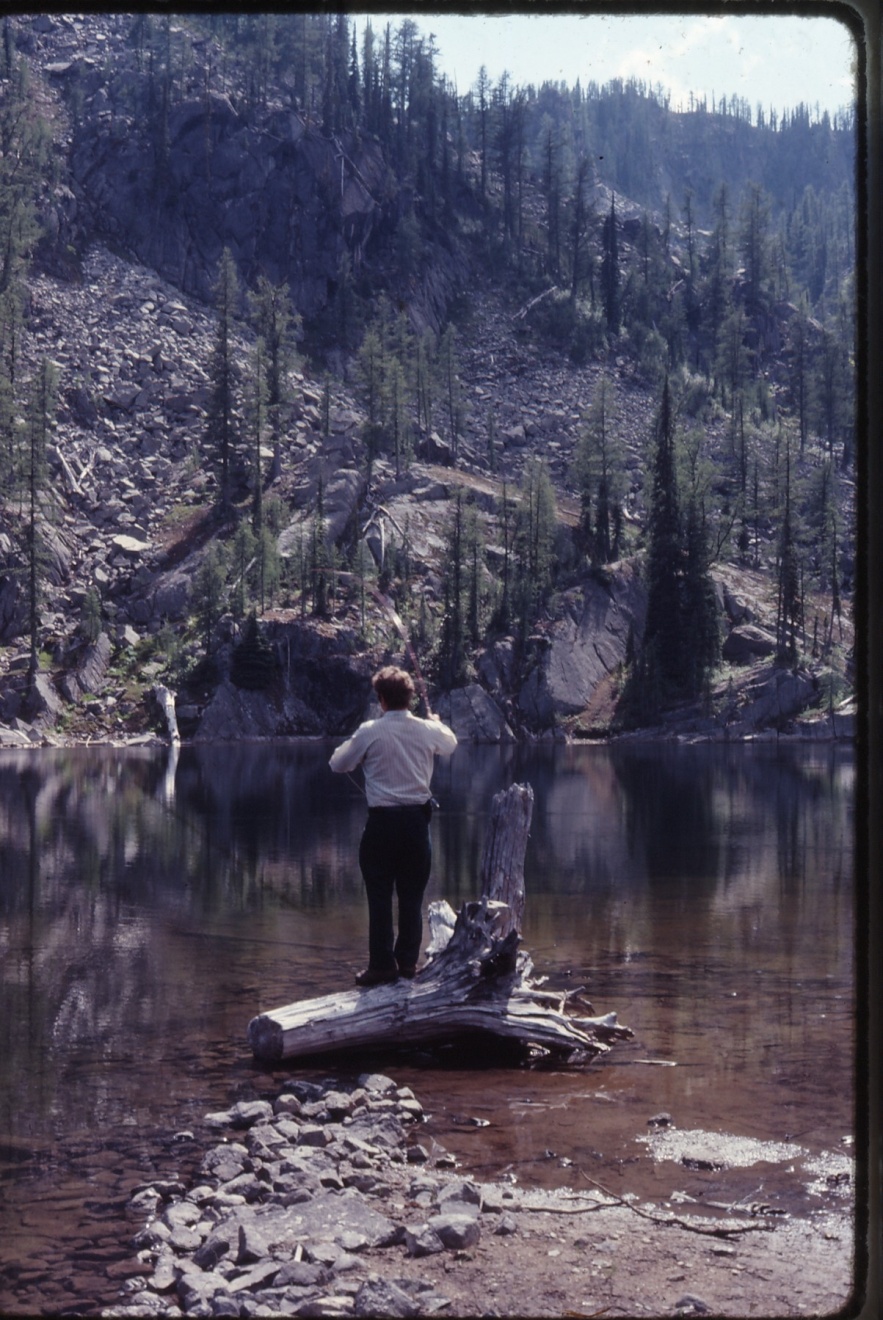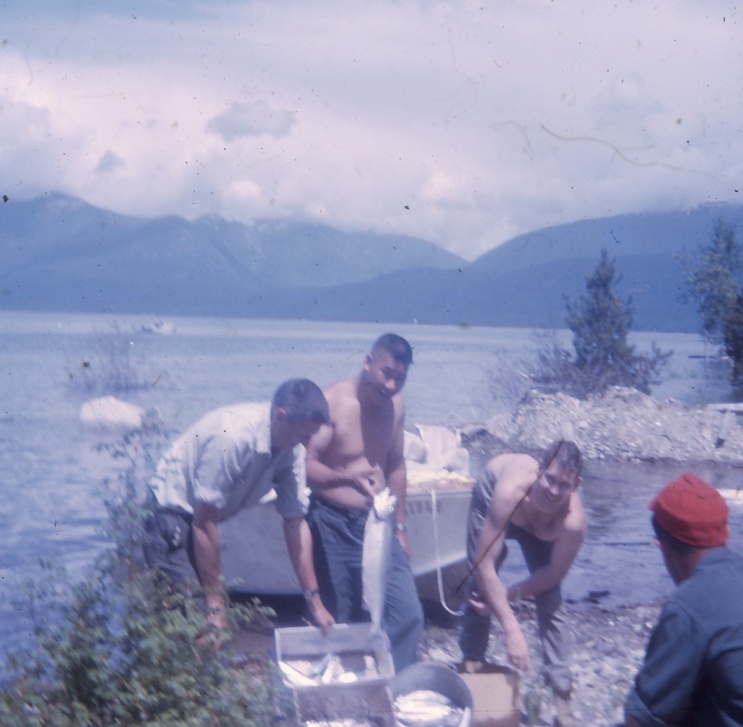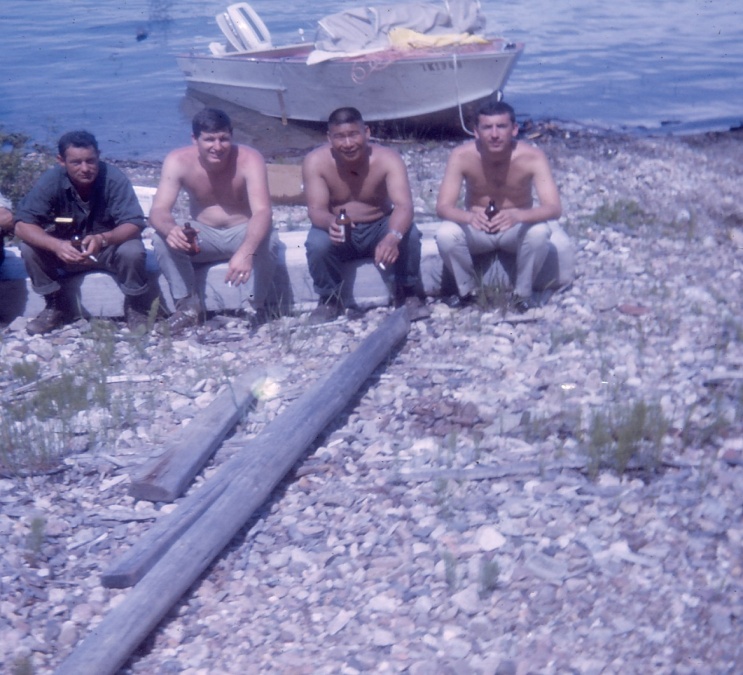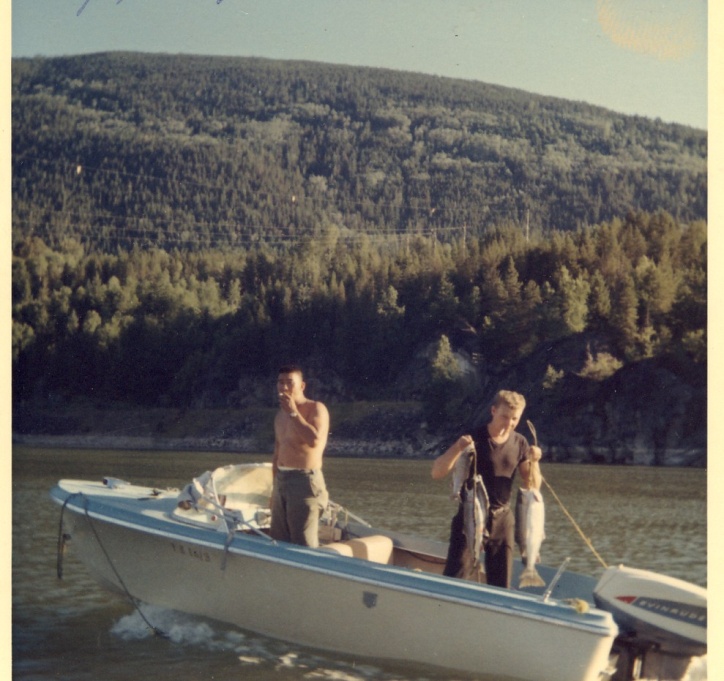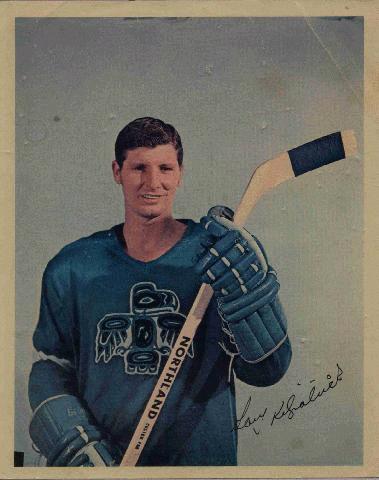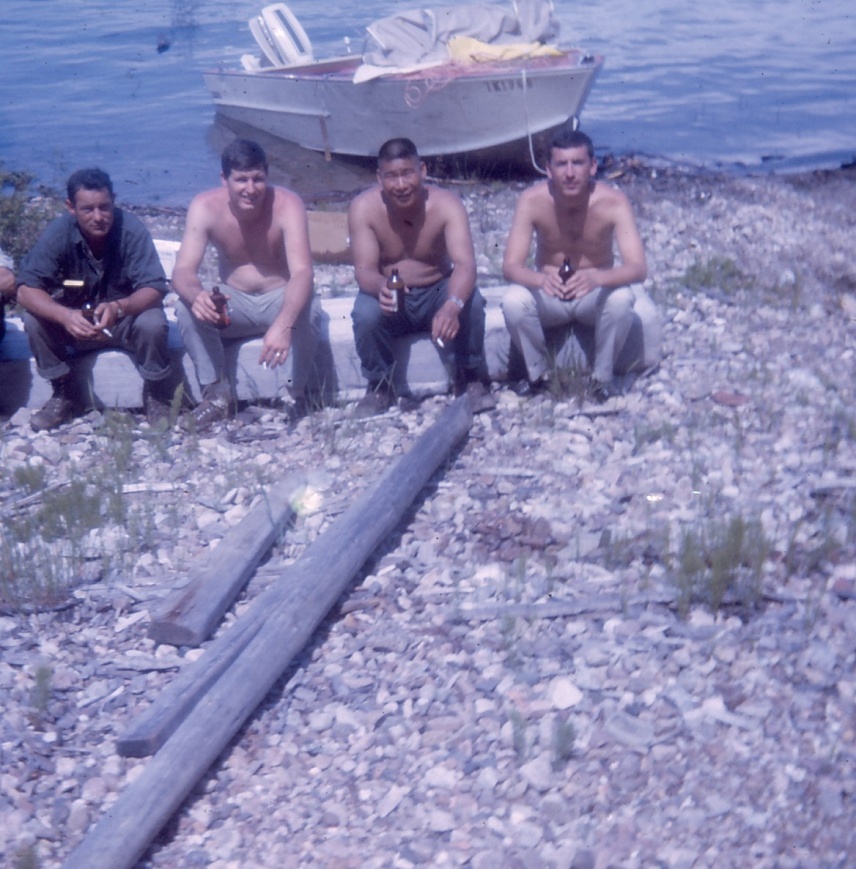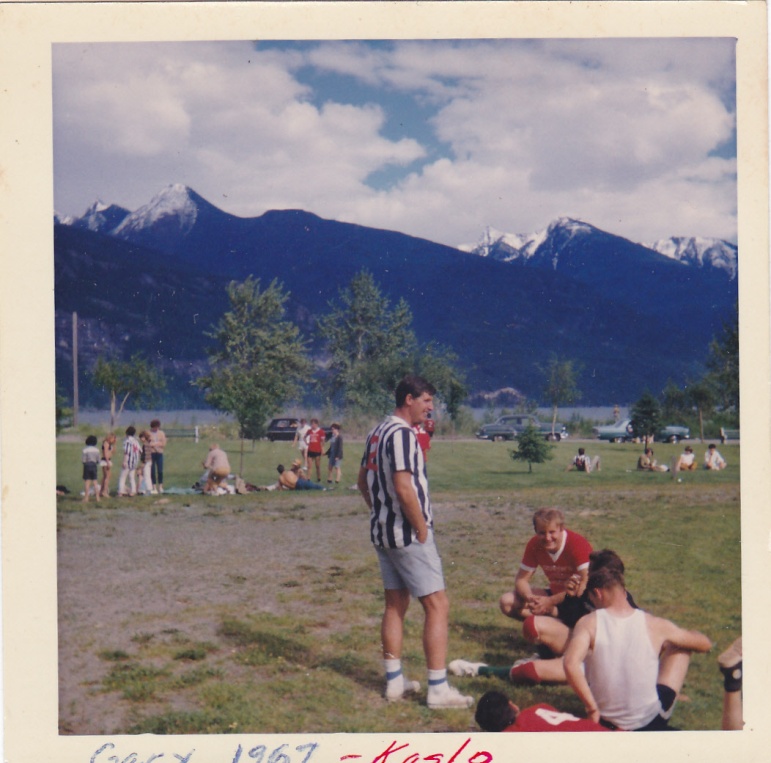CHESTER
As I read thru Alex Kershaw’s Jack London – a Life it occurs to me that two of London’s most popular and acclaimed stories were about dogs. I was also a strong fan of dog stories and was almost always reading a Jack O Brien story like Silver Chief Dog of the North or something by James Oliver Curwood . Then I reasoned why read about them? We had a dog that was every bit as colourful and interesting as any dog of story: Chester was a big, brawling Chesapeake Bay Retriever that was our beloved family dog for about 15 years. We got him as a pup from the McQuarrie family who lived on the North Shore of Nelson near Gordon and Ramona Burn’s summer house off what is now Johnstone Road.
Little did we know that this innocent puppy would bring a rollicking life of good times and high adventure that had to be lived to be believed? Even now, I still marvel at the memories.
Chester became a large curly fellow who lived life to the fullest no matter where we lived. Life with Chess was one of constant surprise. One of the first was the realization that he hated cats. He didn’t just chase them, he killed them. When we lived on Kootenay Street, the old street car barns were next door. Feral cats hung out there and they occasionally wandered through our backyard. Chess was in vigilante mode and attacked when a cat showed. One day a smallish cat showed up and Chess chased him up small maple. As the cat paused to gloat, he forgot his tail was hanging down. Chess jumped up and grabbed it. Game over.
Chester also felt obliged to fight any dog he considered a challenge, so we had some wild brawls.
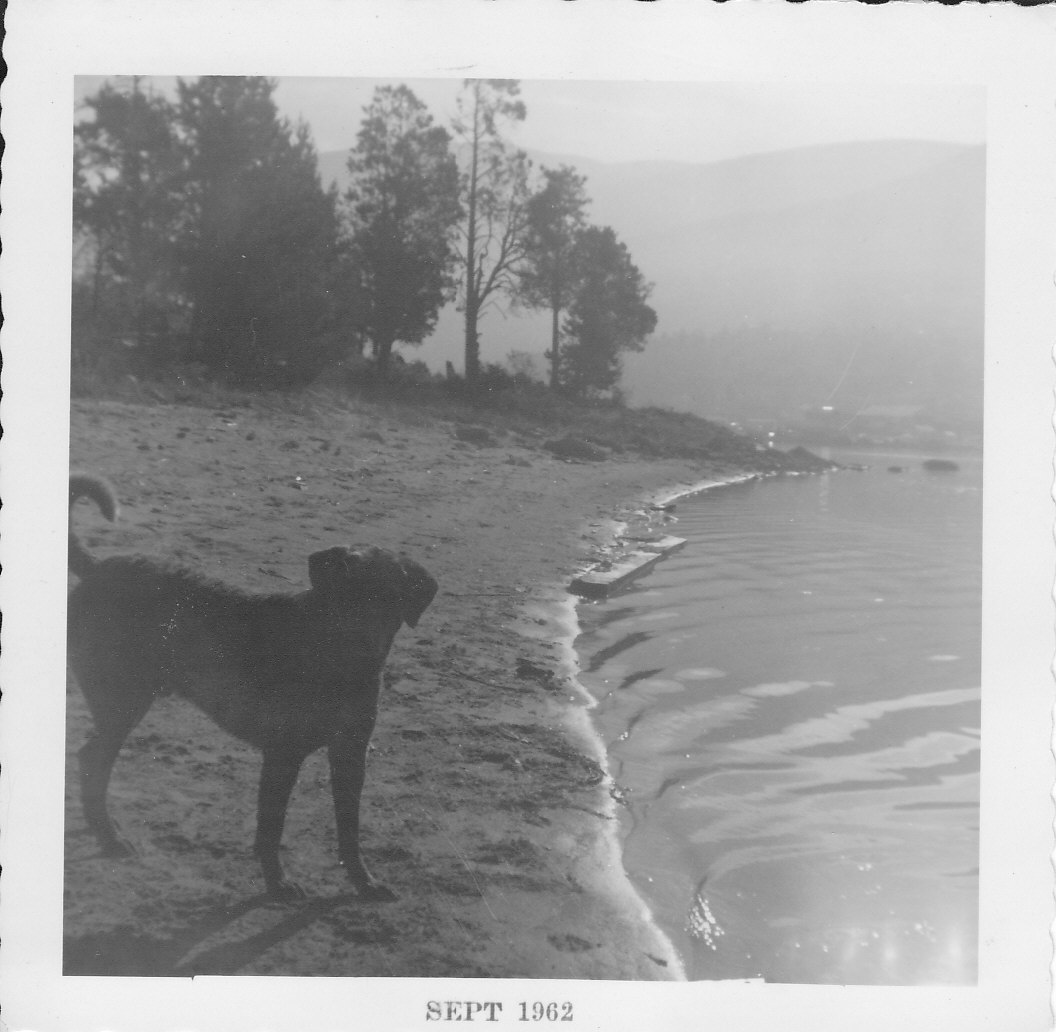
Chess was serious about these fights and some lasted a long time. A neighbour across the lake (Barbara Lang) had a large boxer who also didn’t mind a scrap. They tangled near Gram’s flower bed until they were absolutely spent. Beau (a white dog) was pink with spilled blood. I think Chess got the worst of it. He usually won the first parts of brawls from surprise. H e would charge his opponent bowling them over then go to work but when dogs survived the first hit, Chess could be in for a battle. In the end of this one Beau had Chess by the throat and would not let go. But Beau was holding on to the loose fur of Chester’s ruff doing no harm. Dad finally took the hose to the boneheads before they ran off to lick their wounds.
Chess also liked to eat and required a lot of food. Not long after we had Chess, a new Safeway store opened in Fairview. To mark the occasion, they had a dog food eating contest. Tommy took Chess to the contest that was no contest. They opened the cans of meat above the bowels and were going to spoon out the content. Chester’s meat came out in a one piece blob the shape of the can. Before it landed in the bowel, Chess has snapped it out of the air and swallowed it. He won hands down. Tommy was so proud.
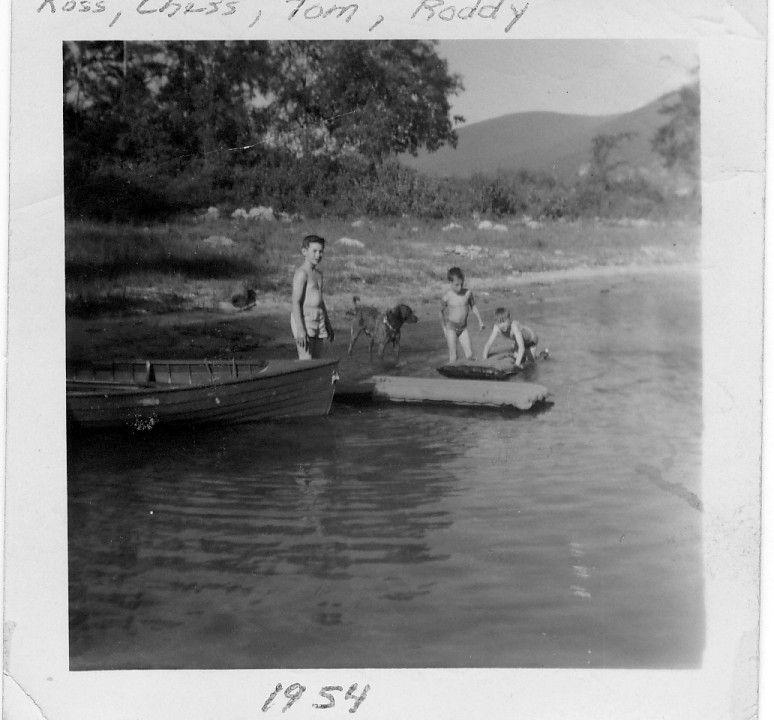
Chess at the beach with Tom and Ross and Rod McKay
Chesapeake’s are one of the best water dogs and Chester was true to form. He was always in or around the water whether there was someone to play with or not. He would fetch his own sticks and rocks and dive for bottles or cans from the boathouse. The dog was interested in everything to do with water. He would swim across the lake and follow us to school even if Mom locked him in the house for an hour or so. When we lived at Kootenay Street he often followed us to church On one occasion on a snowy day around Christmas we just settled our seats near the front of the church when there was a ruckus back by the door I felt a stab of panic. Could it be? He was not around when we left in a second or two there he was, Racing down the aisle. Covered with an inch of wet now. Deliriously happy to find his family. He climbed over everyone in the row shaking and wagging his tail as he passed and licking the faces of people he knew. When he reached us he would sit quietly and pretend to be listening to the sermon until the service ended, then he would charge outside and look for a dog to fight.
Another winter pastime was hockey. He would play with us all day and never seem to tire. On one occasion, he noticed a small flock of mallards keeping a patch of water open by swimming around and around so it would not freeze
Chess charged and launched himself after the ducks. He swam around chasing them for a long time. We thought he might freeze. But he climbed and shook like it was a summer day then resumed chasing the puck as he turned white with frost and his feet bled on the ice.
When I took him fishing he would sit by the rod tip waiting for a bite then launch himself into the water to grab the fish which was usually swimming to freedom by then, Chess would swim in circles looking for it for the longest time. I should have left him home but didn’t have the
Heart for it besides he would eventually show up anyway 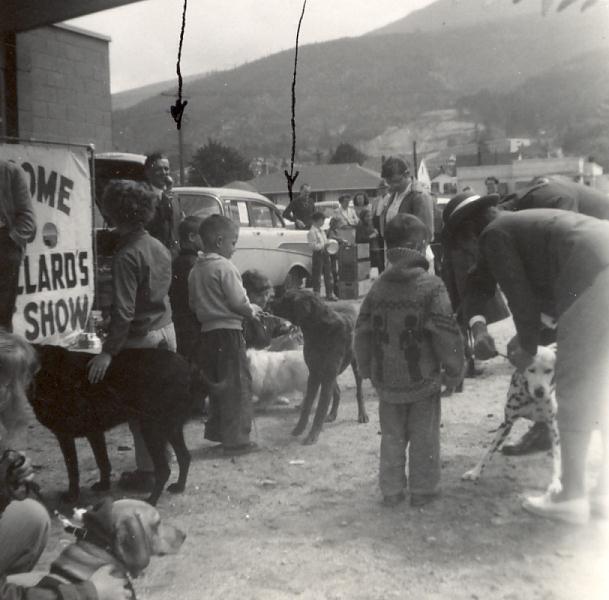
Tommy left ad Chess at Safeway openingin t 195? when Chess won a dog food eating cpntest
Chess was a dog with low impulse control. He was also a glutton.
In the spring I would take him walking along the west part of the beach where there were salt licks. We would get spring water Gram liked for her tea then cut up to the orchard and circle back home. The snow was melting and we found a dead coyote by the spring. I had a quick look and carried on. The carcass was in a state of decomposition. Indeed. I was almost home when I noticed Chess wasn’t with me. I
circled back and sure enough he had devoured the coyote maggots and all!
In summers we often had supper on the porch and food would sometimes sit for awhile unattended. This was too much for Chess. He grabbed both a turkey and a ham and ran for cover. Both times dad hacked him pretty good with a hockey stick but it hardly fazed him. Food was never left to sit again.
Another revelation was his hatred of squirrels. They seemed to know and relish in taunting him. There was a giant fir beside our driveway and a little red squirrel would dash out on the trunk and scold Chester to the edge of madness. He never got within reach of Chester but came pretty close.
In 1958 it was off to California and a new set of adventures. First we lived in Sunnyvale where Chester indulged himself with neighbourhood females. A poodle next door was the first victim so Chess-a-poos added diversity to the local fauna. He could not be contained there either even by a high fence. I watched him leap it one time. He ran at it and leaped high getting his front feet a bit over it. Then he pulled himself up and over.
Next stop was Los Altos where there was a ravine with a seasonal creek and some large oak trees with squirrels! Large California Grey Squirrels who delighted in taunting Chester. They knew where he rested beside a sliding glass door looking over the back yard. The squirrels would sneak right up to the door and chatter at the dog that was usually not asleep. He was waiting for his chance.
One day I left the door open and Chess got his chance. The pair of squirrel’s had a last taunt then headed for the oaks. Chester roared like a Lion but could not do any damage. One squirrel ran out on a limb above Chess lifted his leg then pissed on the enraged dog. I have never seen an animal go as Crazy. The squirrel panicked and ran further out. Chess leaped onto the branch ran right behind the rodent and almost caught him. The squirrel jumped on to the nearby fence and kept going. Chess was hot on his tail. but could not quite connect. One last lunge and the dog fell off the two by four fence top landing on his tail and breaking it.
That was more or less the end of the adventure. He got in one more battle with a big chow. He ran right into the dog’s garage where a lady was hanging clothes on one those collapsible wooden holders. The lady and the rack got knocked over and the chow got roughed up but it was a good scrap and the chow did well. I guess that’s when I realized that Chess was not indestructible. We went back to Nelson after that and he took up his old place sleeping by the fridge with one eye opened in case someone tossed him a wiener. Or he would go for walks with us but he wasn’t quite up to it. He would get too far then cry out in pain. We had to pack him back to the ranch. By then he was a real heavy weight and no one could carry him safely. It wasn’t long then,
good bye old partner I hope you are by a good lake in squirrel country where they are not too quick. I think of you often and miss every moment we were together. Sometimes I look for your tracks on the beach. They are never there anymore.
CHESTER
As I read thru Alex Kershaw’s Jack London – a Life it occurs to me that two of London’s most popular and acclaimed stories were about dogs. I was also a strong fan of dog stories and was almost always reading a Jack O Brien story like Silver Chief Dog of the North or something by James Oliver Curwood . Then I reasoned why read about them? We had a dog that was every bit as colourful and interesting as any dog of story: Chester was a big, brawling Chesapeake Bay Retriever that was our beloved family dog for about 15 years. We got him as a pup from the McQuarrie family who lived on the North Shore of Nelson near Gordon and Ramona Burn’s summer house off what is now Johnstone Road.
Little did we know that this innocent puppy would bring a rollicking life of good times and high adventure that had to be lived to be believed? Even now, I still marvel at the memories.
Chester became a large curly fellow who lived life to the fullest no matter where we lived. Life with Chess was one of constant surprise. One of the first was the realization that he hated cats. He didn’t just chase them, he killed them. When we lived on Kootenay Street, the old street car barns were next door. Feral cats hung out there and they occasionally wandered through our backyard. Chess was in vigilante mode and attacked when a cat showed. One day a smallish cat showed up and Chess chased him up small maple. As the cat paused to gloat, he forgot his tail was hanging down. Chess jumped up and grabbed it. Game over.
Chester also felt obliged to fight any dog he considered a challenge, so we had some wild brawls.
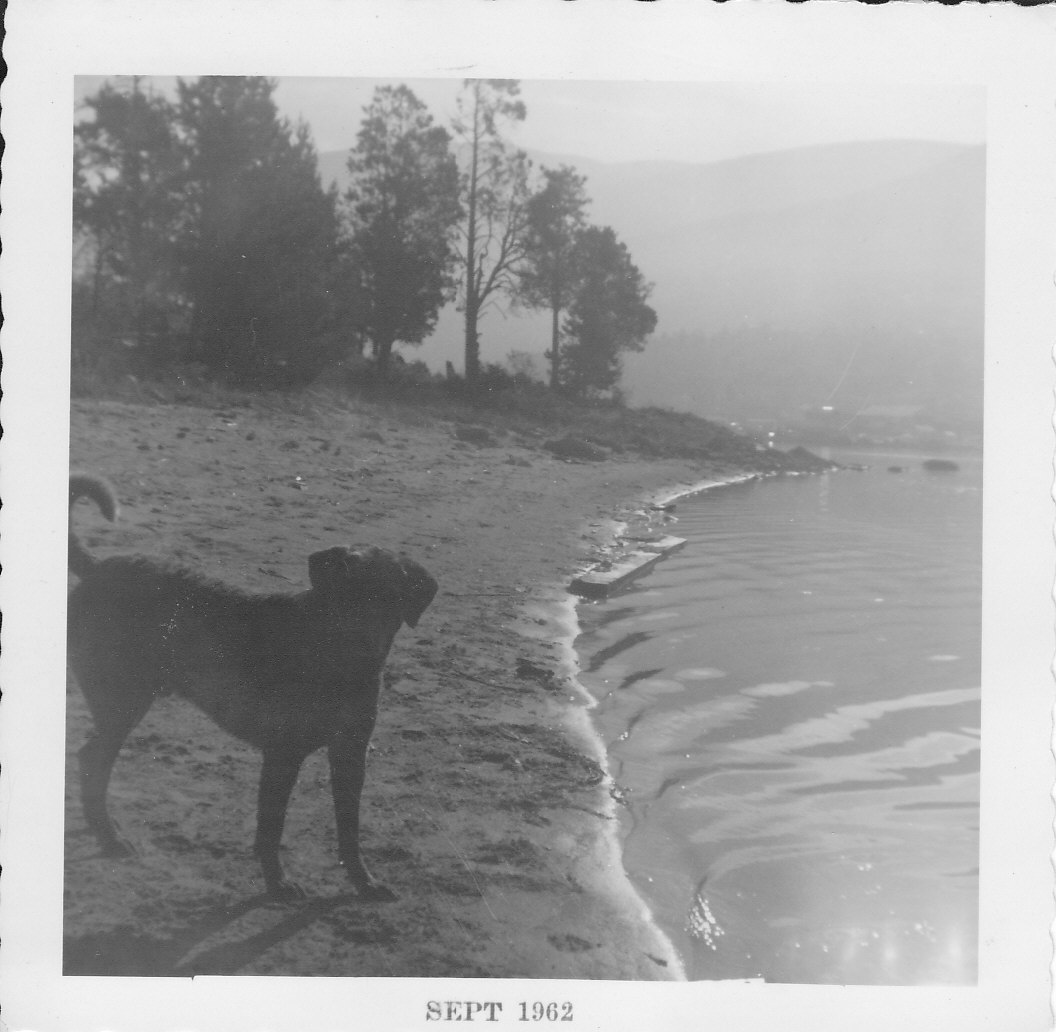
Chess was serious about these fights and some lasted a long time. A neighbour across the lake (Barbara Lang) had a large boxer who also didn’t mind a scrap. They tangled near Gram’s flower bed until they were absolutely spent. Beau (a white dog) was pink with spilled blood. I think Chess got the worst of it. He usually won the first parts of brawls from surprise. H e would charge his opponent bowling them over then go to work but when dogs survived the first hit, Chess could be in for a battle. In the end of this one Beau had Chess by the throat and would not let go. But Beau was holding on to the loose fur of Chester’s ruff doing no harm. Dad finally took the hose to the boneheads before they ran off to lick their wounds.
Chess also liked to eat and required a lot of food. Not long after we had Chess, a new Safeway store opened in Fairview. To mark the occasion, they had a dog food eating contest. Tommy took Chess to the contest that was no contest. They opened the cans of meat above the bowels and were going to spoon out the content. Chester’s meat came out in a one piece blob the shape of the can. Before it landed in the bowel, Chess has snapped it out of the air and swallowed it. He won hands down. Tommy was so proud.
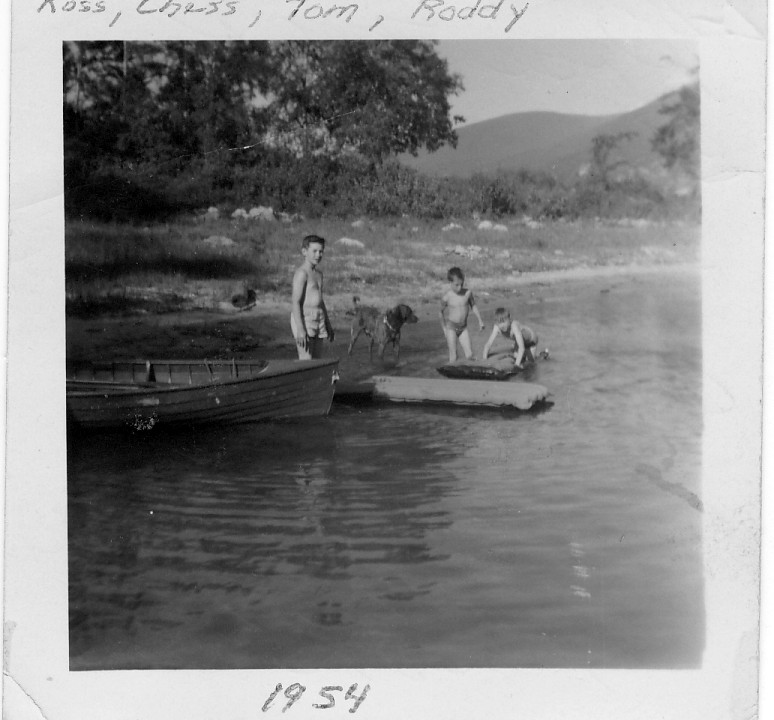
Chess at the beach with Tom and Ross and Rod McKay
Chesapeake’s are one of the best water dogs and Chester was true to form. He was always in or around the water whether there was someone to play with or not. He would fetch his own sticks and rocks and dive for bottles or cans from the boathouse. The dog was interested in everything to do with water. He would swim across the lake and follow us to school even if Mom locked him in the house for an hour or so. When we lived at Kootenay Street he often followed us to church On one occasion on a snowy day around Christmas we just settled our seats near the front of the church when there was a ruckus back by the door I felt a stab of panic. Could it be? He was not around when we left in a second or two there he was, Racing down the aisle. Covered with an inch of wet now. Deliriously happy to find his family. He climbed over everyone in the row shaking and wagging his tail as he passed and licking the faces of people he knew. When he reached us he would sit quietly and pretend to be listening to the sermon until the service ended, then he would charge outside and look for a dog to fight.
Another winter pastime was hockey. He would play with us all day and never seem to tire. On one occasion, he noticed a small flock of mallards keeping a patch of water open by swimming around and around so it would not freeze
Chess charged and launched himself after the ducks. He swam around chasing them for a long time. We thought he might freeze. But he climbed and shook like it was a summer day then resumed chasing the puck as he turned white with frost and his feet bled on the ice.
When I took him fishing he would sit by the rod tip waiting for a bite then launch himself into the water to grab the fish which was usually swimming to freedom by then, Chess would swim in circles looking for it for the longest time. I should have left him home but didn’t have the
Heart for it besides he would eventually show up anyway 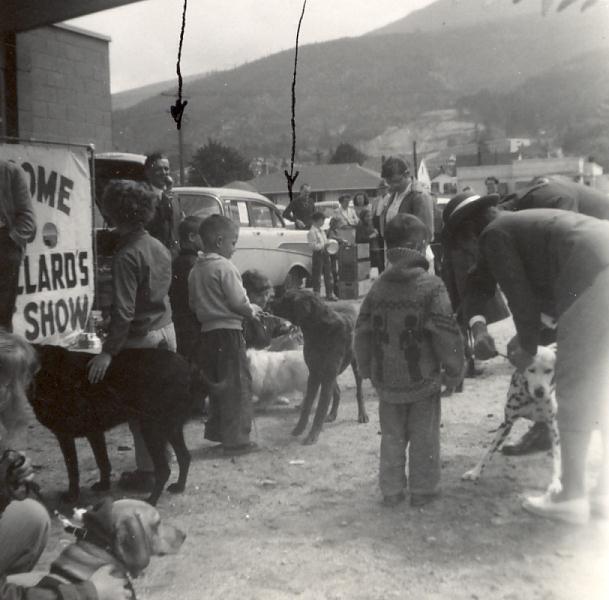
Tommy left ad Chess at Safeway openingin t 195? when Chess won a dog food eating cpntest
Chess was a dog with low impulse control. He was also a glutton.
In the spring I would take him walking along the west part of the beach where there were salt licks. We would get spring water Gram liked for her tea then cut up to the orchard and circle back home. The snow was melting and we found a dead coyote by the spring. I had a quick look and carried on. The carcass was in a state of decomposition. Indeed. I was almost home when I noticed Chess wasn’t with me. I
circled back and sure enough he had devoured the coyote maggots and all!
In summers we often had supper on the porch and food would sometimes sit for awhile unattended. This was too much for Chess. He grabbed both a turkey and a ham and ran for cover. Both times dad hacked him pretty good with a hockey stick but it hardly fazed him. Food was never left to sit again.
Another revelation was his hatred of squirrels. They seemed to know and relish in taunting him. There was a giant fir beside our driveway and a little red squirrel would dash out on the trunk and scold Chester to the edge of madness. He never got within reach of Chester but came pretty close.
In 1958 it was off to California and a new set of adventures. First we lived in Sunnyvale where Chester indulged himself with neighbourhood females. A poodle next door was the first victim so Chess-a-poos added diversity to the local fauna. He could not be contained there either even by a high fence. I watched him leap it one time. He ran at it and leaped high getting his front feet a bit over it. Then he pulled himself up and over.
Next stop was Los Altos where there was a ravine with a seasonal creek and some large oak trees with squirrels! Large California Grey Squirrels who delighted in taunting Chester. They knew where he rested beside a sliding glass door looking over the back yard. The squirrels would sneak right up to the door and chatter at the dog that was usually not asleep. He was waiting for his chance.
One day I left the door open and Chess got his chance. The pair of squirrel’s had a last taunt then headed for the oaks. Chester roared like a Lion but could not do any damage. One squirrel ran out on a limb above Chess lifted his leg then pissed on the enraged dog. I have never seen an animal go as Crazy. The squirrel panicked and ran further out. Chess leaped onto the branch ran right behind the rodent and almost caught him. The squirrel jumped on to the nearby fence and kept going. Chess was hot on his tail. but could not quite connect. One last lunge and the dog fell off the two by four fence top landing on his tail and breaking it.
That was more or less the end of the adventure. He got in one more battle with a big chow. He ran right into the dog’s garage where a lady was hanging clothes on one those collapsible wooden holders. The lady and the rack got knocked over and the chow got roughed up but it was a good scrap and the chow did well. I guess that’s when I realized that Chess was not indestructible. We went back to Nelson after that and he took up his old place sleeping by the fridge with one eye opened in case someone tossed him a wiener. Or he would go for walks with us but he wasn’t quite up to it. He would get too far then cry out in pain. We had to pack him back to the ranch. By then he was a real heavy weight and no one could carry him safely. It wasn’t long then,
good bye old partner I hope you are by a good lake in squirrel country where they are not too quick. I think of you often and miss every moment we were together. Sometimes I look for your tracks on the beach. They are never there anymore.
CHESTER
As I read thru Alex Kershaw’s Jack London – a Life it occurs to me that two of London’s most popular and acclaimed stories were about dogs. I was also a strong fan of dog stories and was almost always reading a Jack O Brien story like Silver Chief Dog of the North or something by James Oliver Curwood . Then I reasoned why read about them? We had a dog that was every bit as colourful and interesting as any dog of story: Chester was a big, brawling Chesapeake Bay Retriever that was our beloved family dog for about 15 years. We got him as a pup from the McQuarrie family who lived on the North Shore of Nelson near Gordon and Ramona Burn’s summer house off what is now Johnstone Road.
Little did we know that this innocent puppy would bring a rollicking life of good times and high adventure that had to be lived to be believed? Even now, I still marvel at the memories.
Chester became a large curly fellow who lived life to the fullest no matter where we lived. Life with Chess was one of constant surprise. One of the first was the realization that he hated cats. He didn’t just chase them, he killed them. When we lived on Kootenay Street, the old street car barns were next door. Feral cats hung out there and they occasionally wandered through our backyard. Chess was in vigilante mode and attacked when a cat showed. One day a smallish cat showed up and Chess chased him up small maple. As the cat paused to gloat, he forgot his tail was hanging down. Chess jumped up and grabbed it. Game over.
Chester also felt obliged to fight any dog he considered a challenge, so we had some wild brawls.
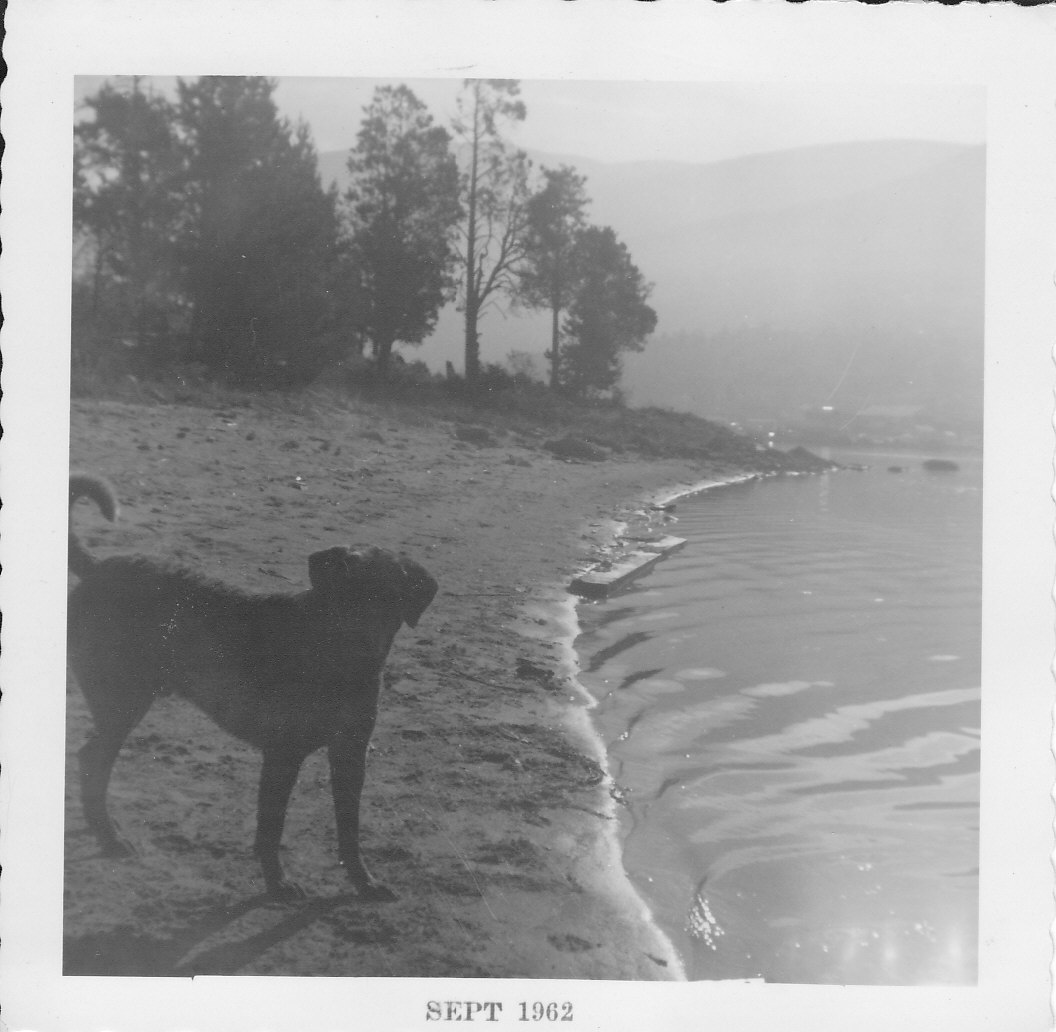
Chess was serious about these fights and some lasted a long time. A neighbour across the lake (Barbara Lang) had a large boxer who also didn’t mind a scrap. They tangled near Gram’s flower bed until they were absolutely spent. Beau (a white dog) was pink with spilled blood. I think Chess got the worst of it. He usually won the first parts of brawls from surprise. H e would charge his opponent bowling them over then go to work but when dogs survived the first hit, Chess could be in for a battle. In the end of this one Beau had Chess by the throat and would not let go. But Beau was holding on to the loose fur of Chester’s ruff doing no harm. Dad finally took the hose to the boneheads before they ran off to lick their wounds.
Chess also liked to eat and required a lot of food. Not long after we had Chess, a new Safeway store opened in Fairview. To mark the occasion, they had a dog food eating contest. Tommy took Chess to the contest that was no contest. They opened the cans of meat above the bowels and were going to spoon out the content. Chester’s meat came out in a one piece blob the shape of the can. Before it landed in the bowel, Chess has snapped it out of the air and swallowed it. He won hands down. Tommy was so proud.
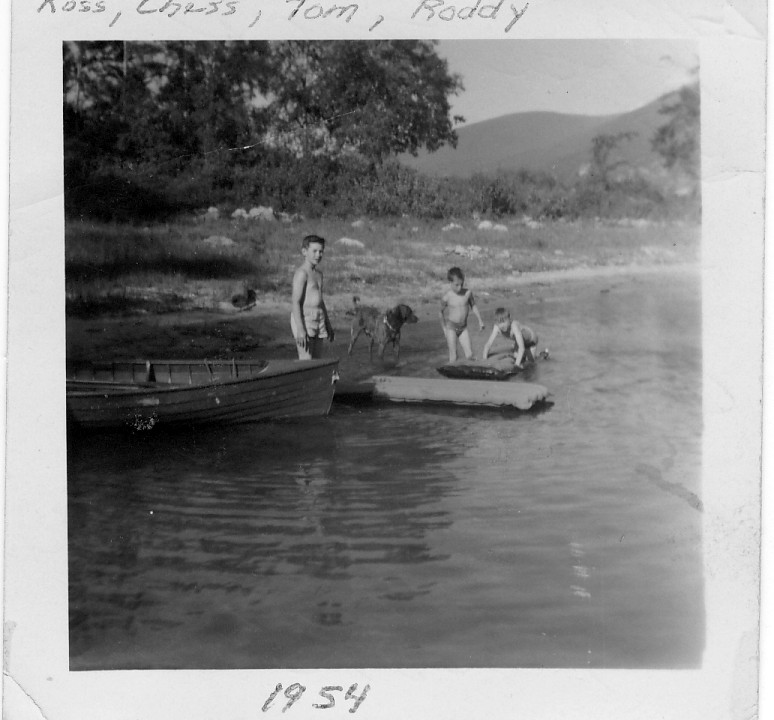
Chess at the beach with Tom and Ross and Rod McKay
Chesapeake’s are one of the best water dogs and Chester was true to form. He was always in or around the water whether there was someone to play with or not. He would fetch his own sticks and rocks and dive for bottles or cans from the boathouse. The dog was interested in everything to do with water. He would swim across the lake and follow us to school even if Mom locked him in the house for an hour or so. When we lived at Kootenay Street he often followed us to church On one occasion on a snowy day around Christmas we just settled our seats near the front of the church when there was a ruckus back by the door I felt a stab of panic. Could it be? He was not around when we left in a second or two there he was, Racing down the aisle. Covered with an inch of wet now. Deliriously happy to find his family. He climbed over everyone in the row shaking and wagging his tail as he passed and licking the faces of people he knew. When he reached us he would sit quietly and pretend to be listening to the sermon until the service ended, then he would charge outside and look for a dog to fight.
Another winter pastime was hockey. He would play with us all day and never seem to tire. On one occasion, he noticed a small flock of mallards keeping a patch of water open by swimming around and around so it would not freeze
Chess charged and launched himself after the ducks. He swam around chasing them for a long time. We thought he might freeze. But he climbed and shook like it was a summer day then resumed chasing the puck as he turned white with frost and his feet bled on the ice.
When I took him fishing he would sit by the rod tip waiting for a bite then launch himself into the water to grab the fish which was usually swimming to freedom by then, Chess would swim in circles looking for it for the longest time. I should have left him home but didn’t have the
Heart for it besides he would eventually show up anyway 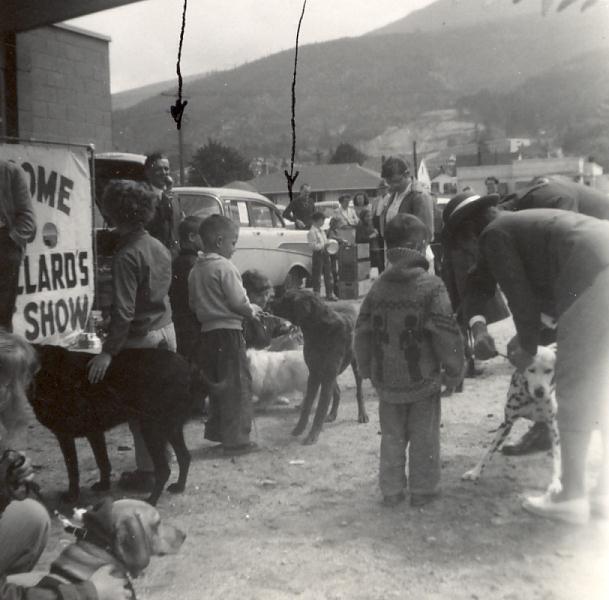
Tommy left ad Chess at Safeway openingin t 195? when Chess won a dog food eating cpntest
Chess was a dog with low impulse control. He was also a glutton.
In the spring I would take him walking along the west part of the beach where there were salt licks. We would get spring water Gram liked for her tea then cut up to the orchard and circle back home. The snow was melting and we found a dead coyote by the spring. I had a quick look and carried on. The carcass was in a state of decomposition. Indeed. I was almost home when I noticed Chess wasn’t with me. I
circled back and sure enough he had devoured the coyote maggots and all!
In summers we often had supper on the porch and food would sometimes sit for awhile unattended. This was too much for Chess. He grabbed both a turkey and a ham and ran for cover. Both times dad hacked him pretty good with a hockey stick but it hardly fazed him. Food was never left to sit again.
Another revelation was his hatred of squirrels. They seemed to know and relish in taunting him. There was a giant fir beside our driveway and a little red squirrel would dash out on the trunk and scold Chester to the edge of madness. He never got within reach of Chester but came pretty close.
In 1958 it was off to California and a new set of adventures. First we lived in Sunnyvale where Chester indulged himself with neighbourhood females. A poodle next door was the first victim so Chess-a-poos added diversity to the local fauna. He could not be contained there either even by a high fence. I watched him leap it one time. He ran at it and leaped high getting his front feet a bit over it. Then he pulled himself up and over.
Next stop was Los Altos where there was a ravine with a seasonal creek and some large oak trees with squirrels! Large California Grey Squirrels who delighted in taunting Chester. They knew where he rested beside a sliding glass door looking over the back yard. The squirrels would sneak right up to the door and chatter at the dog that was usually not asleep. He was waiting for his chance.
One day I left the door open and Chess got his chance. The pair of squirrel’s had a last taunt then headed for the oaks. Chester roared like a Lion but could not do any damage. One squirrel ran out on a limb above Chess lifted his leg then pissed on the enraged dog. I have never seen an animal go as Crazy. The squirrel panicked and ran further out. Chess leaped onto the branch ran right behind the rodent and almost caught him. The squirrel jumped on to the nearby fence and kept going. Chess was hot on his tail. but could not quite connect. One last lunge and the dog fell off the two by four fence top landing on his tail and breaking it.
That was more or less the end of the adventure. He got in one more battle with a big chow. He ran right into the dog’s garage where a lady was hanging clothes on one those collapsible wooden holders. The lady and the rack got knocked over and the chow got roughed up but it was a good scrap and the chow did well. I guess that’s when I realized that Chess was not indestructible. We went back to Nelson after that and he took up his old place sleeping by the fridge with one eye opened in case someone tossed him a wiener. Or he would go for walks with us but he wasn’t quite up to it. He would get too far then cry out in pain. We had to pack him back to the ranch. By then he was a real heavy weight and no one could carry him safely. It wasn’t long then,
good bye old partner I hope you are by a good lake in squirrel country where they are not too quick. I think of you often and miss every moment we were together. Sometimes I look for your tracks on the beach. They are never there anymore.



 George Doi at 88. Still going strong
George Doi at 88. Still going strong








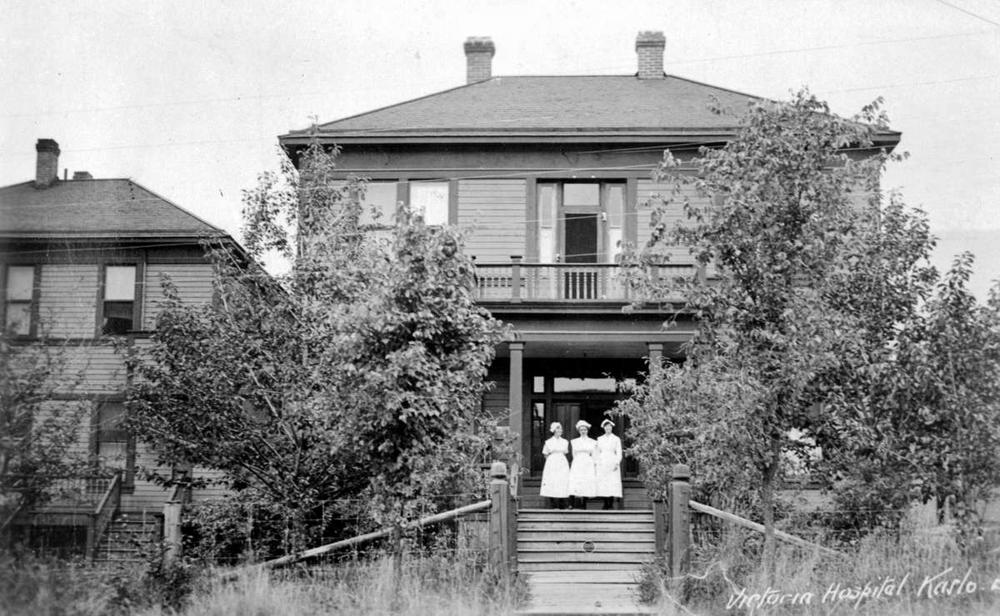 The old Victorian Hospital in Kaslo.
The old Victorian Hospital in Kaslo.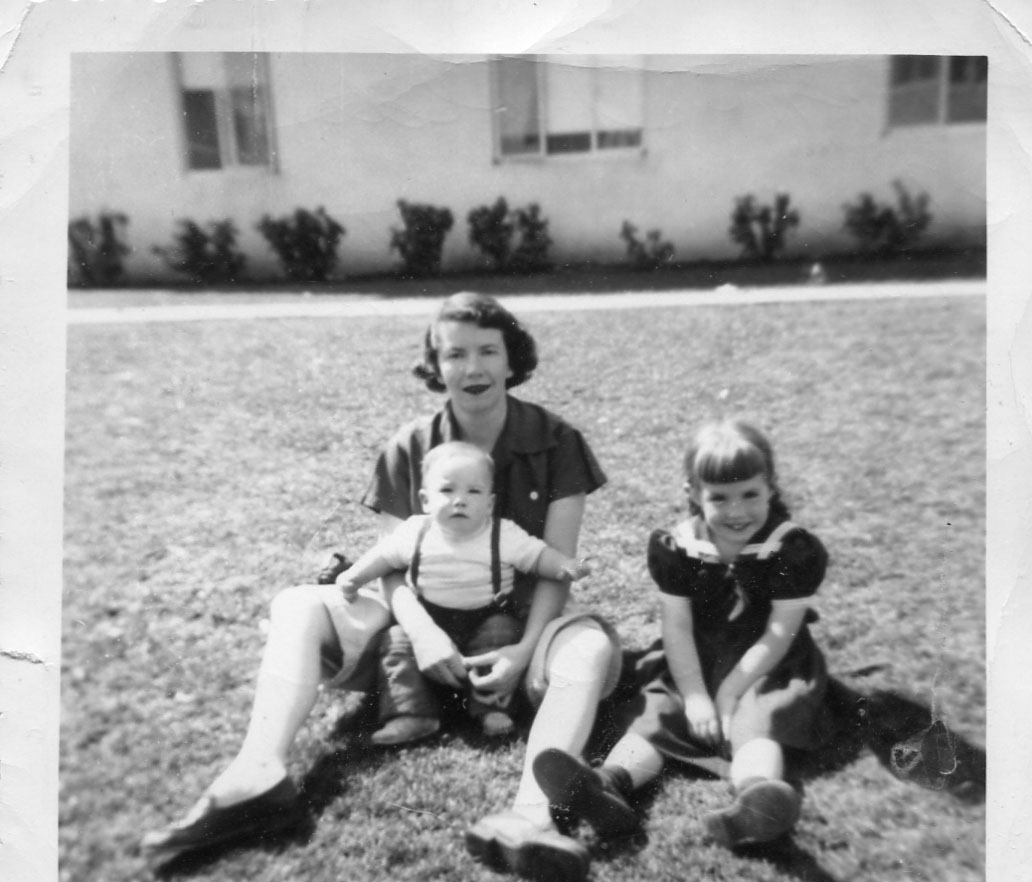
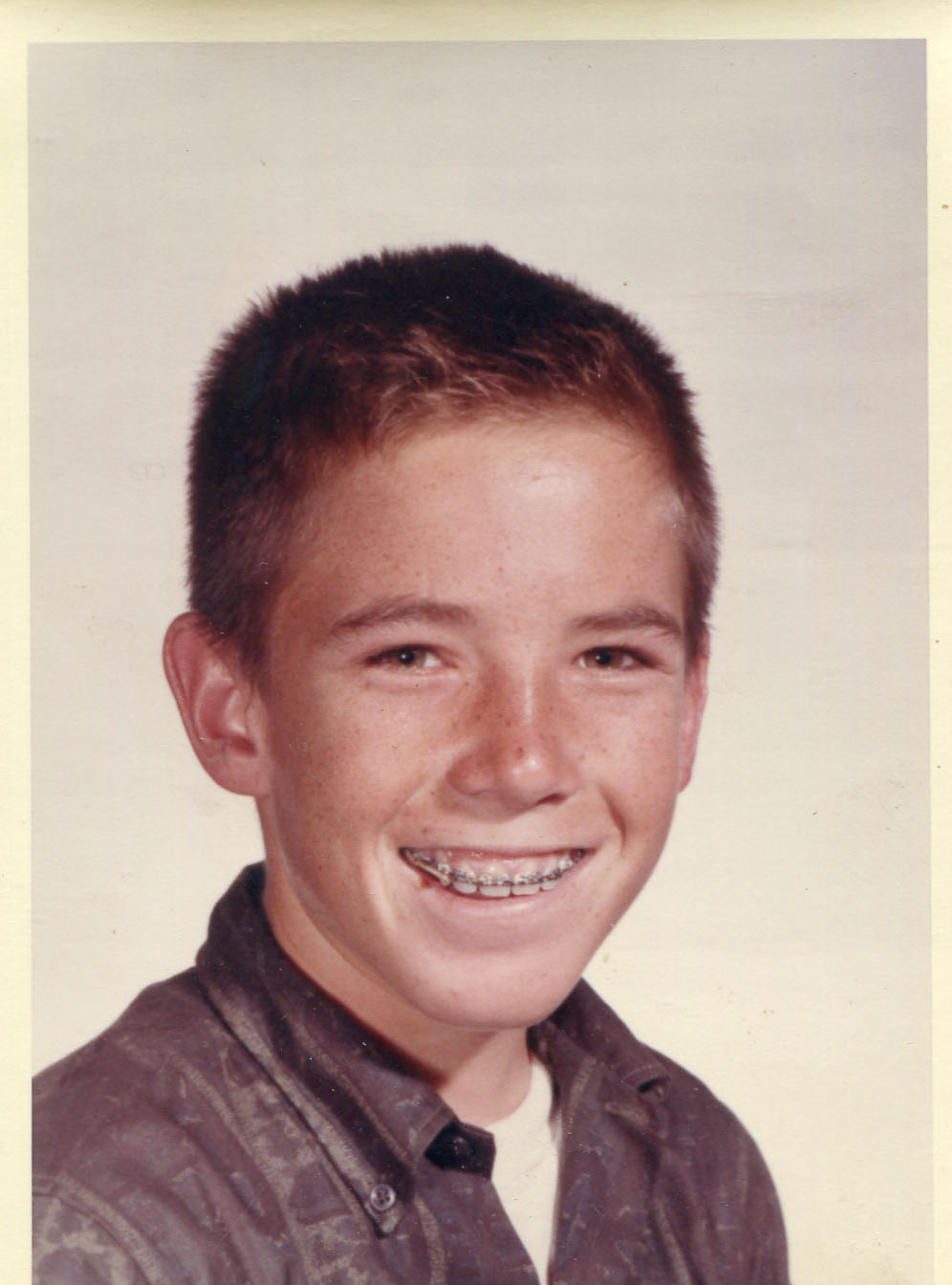
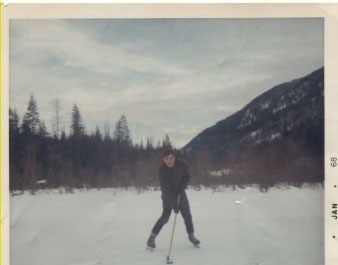
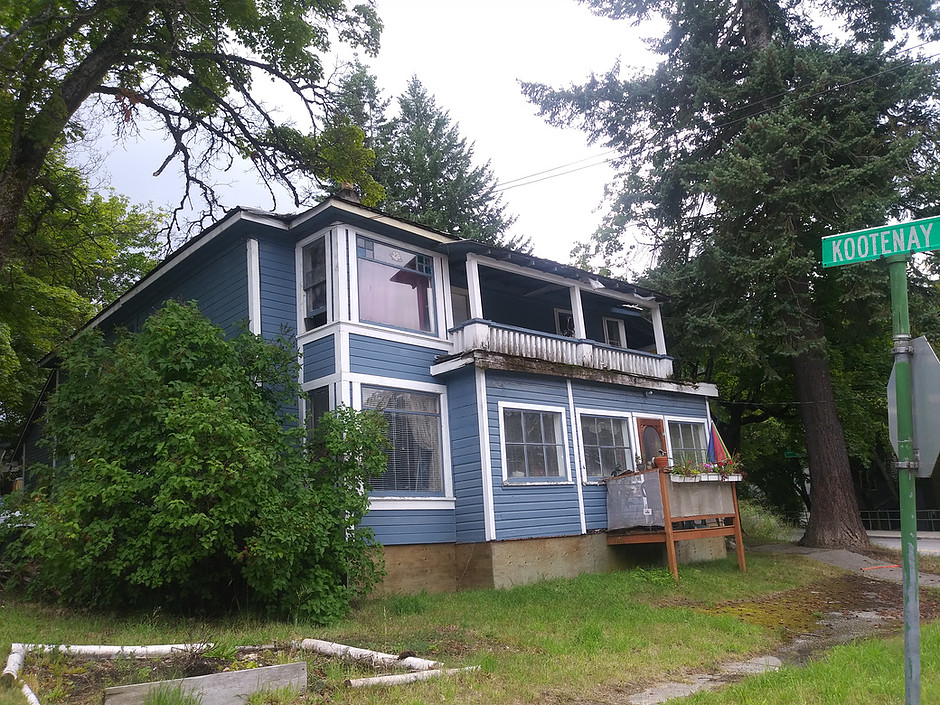
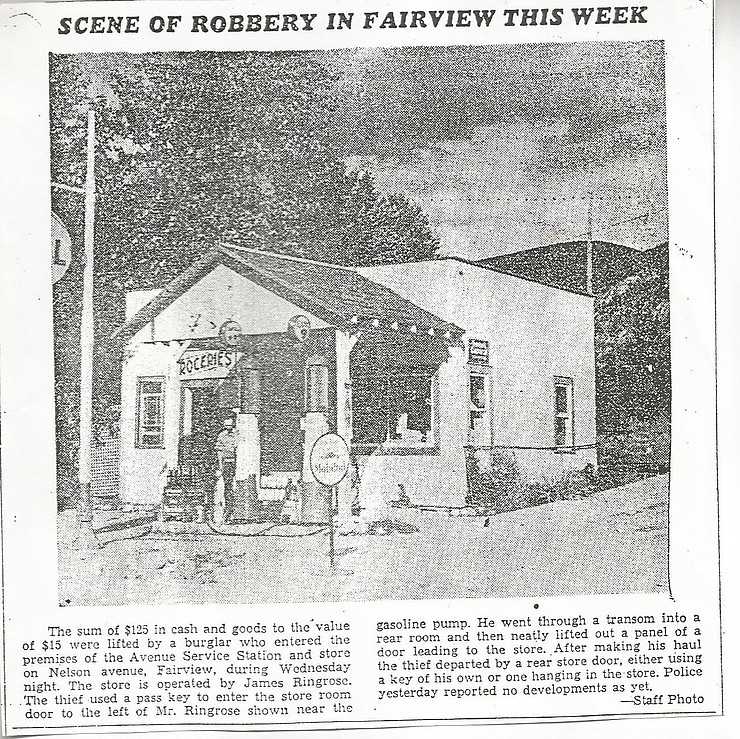
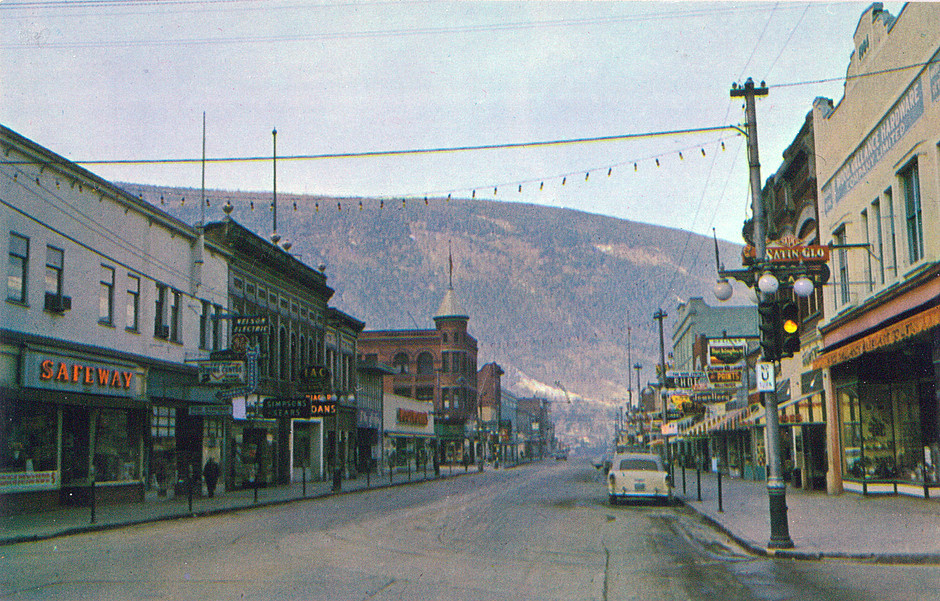
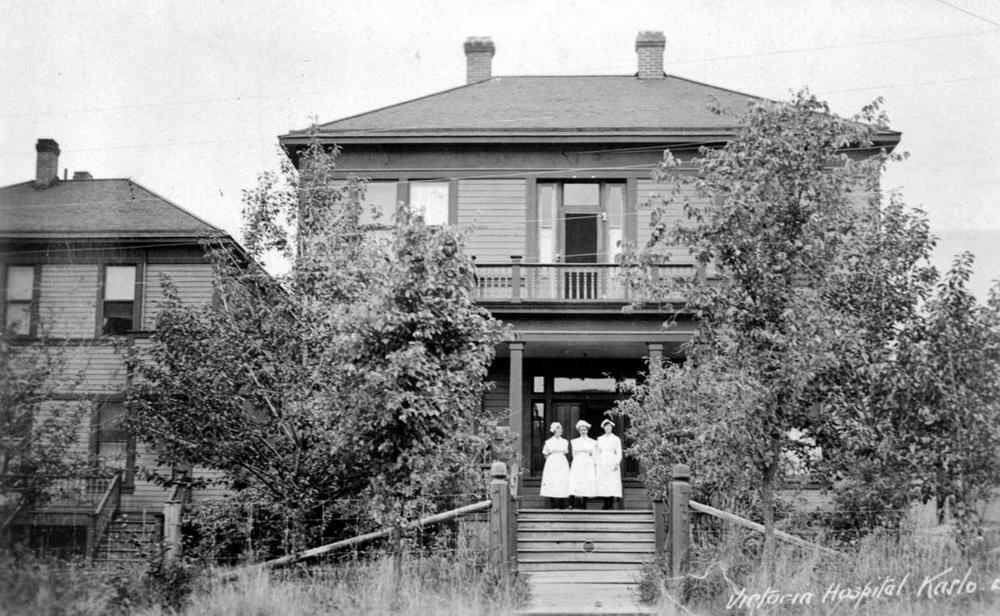 The old Victorian Hospital in Kaslo.
The old Victorian Hospital in Kaslo.